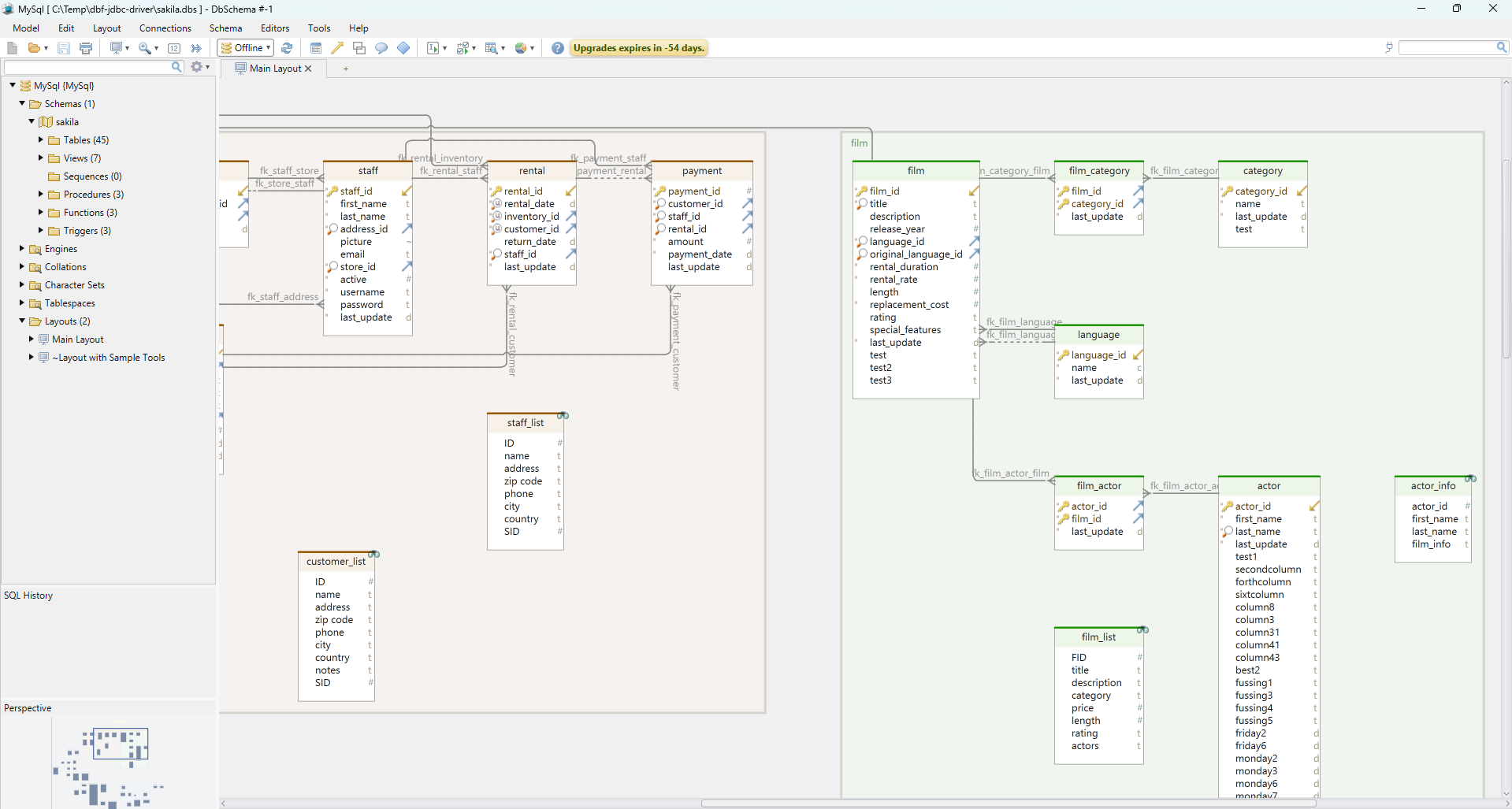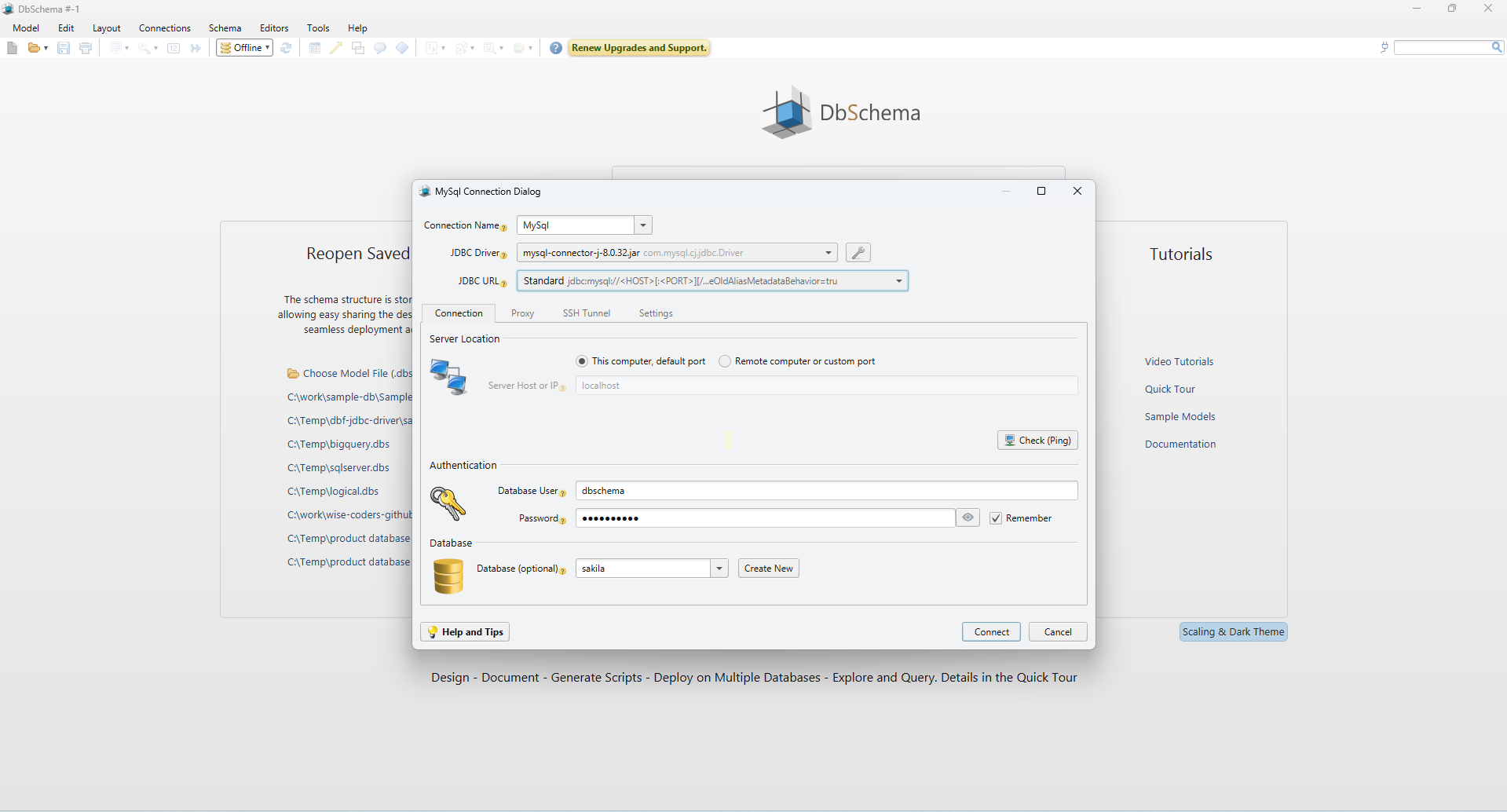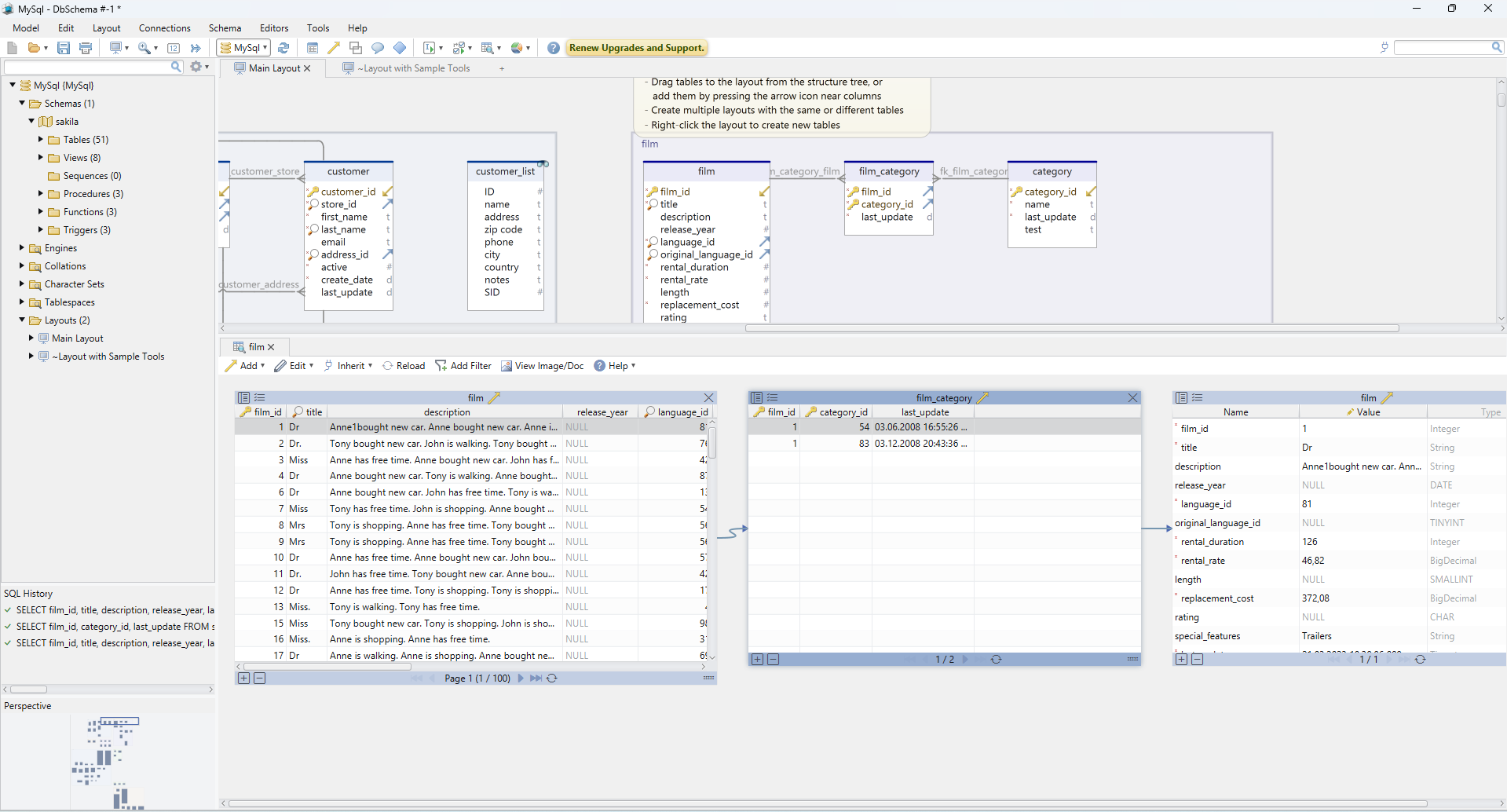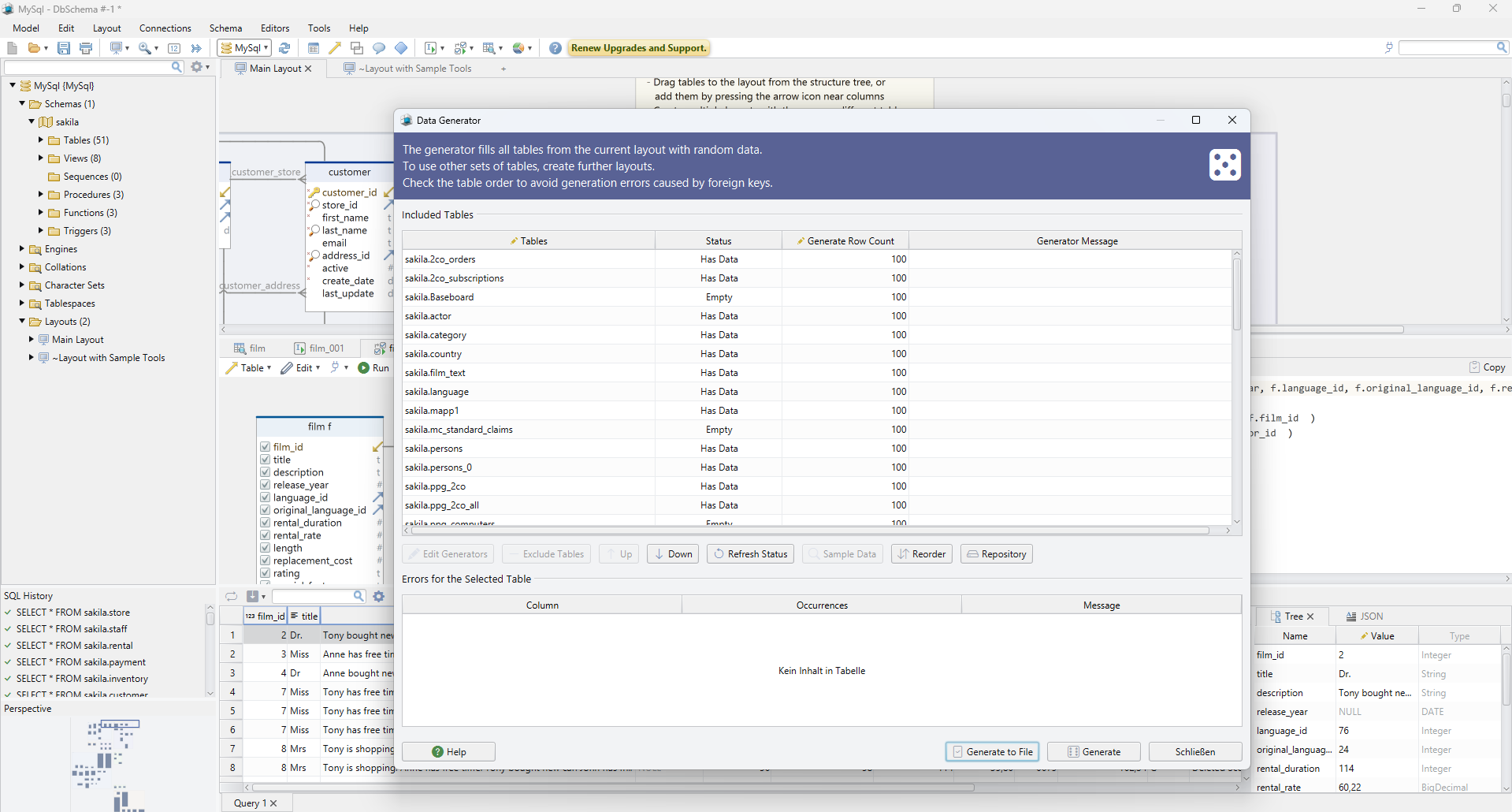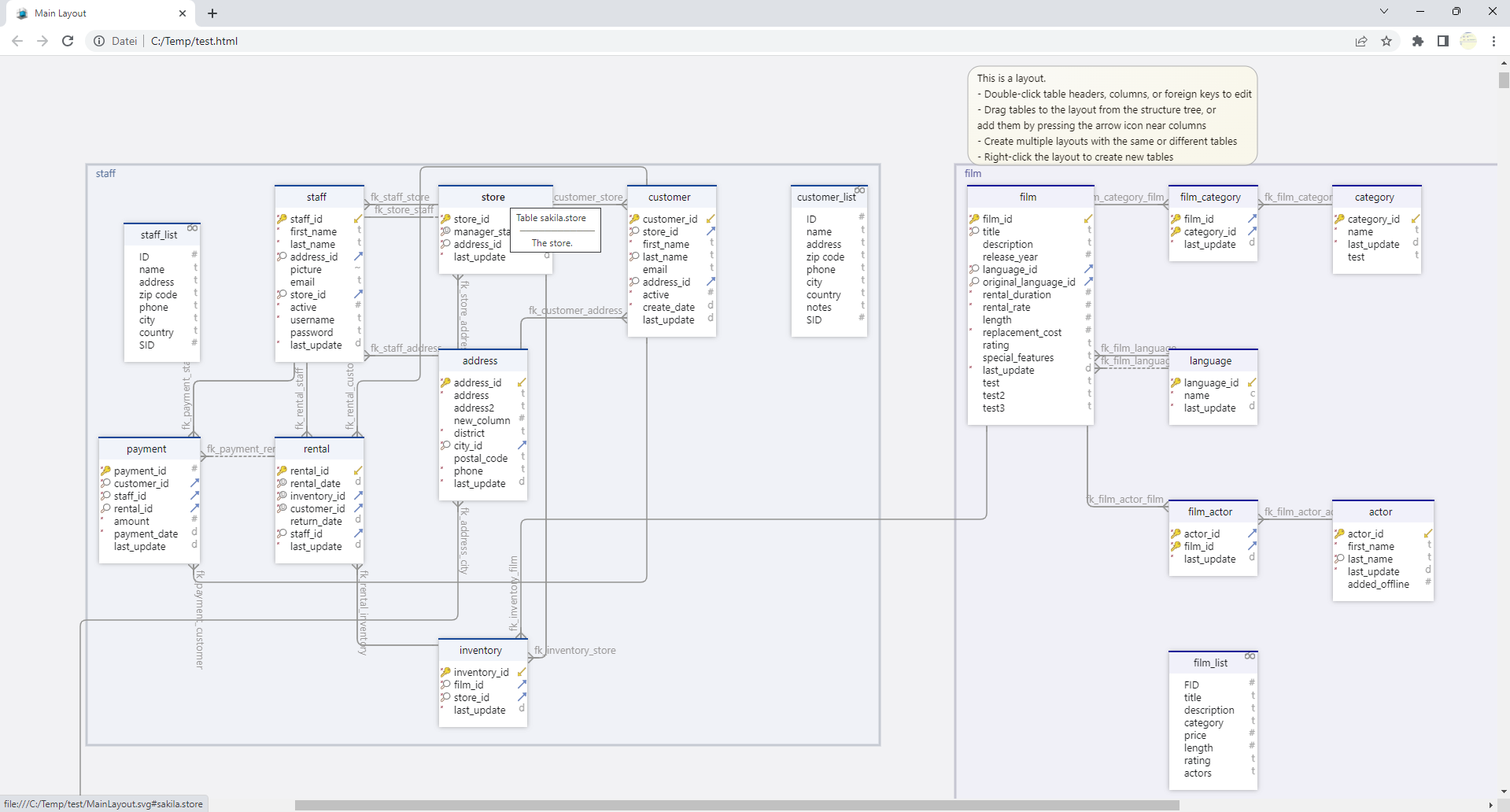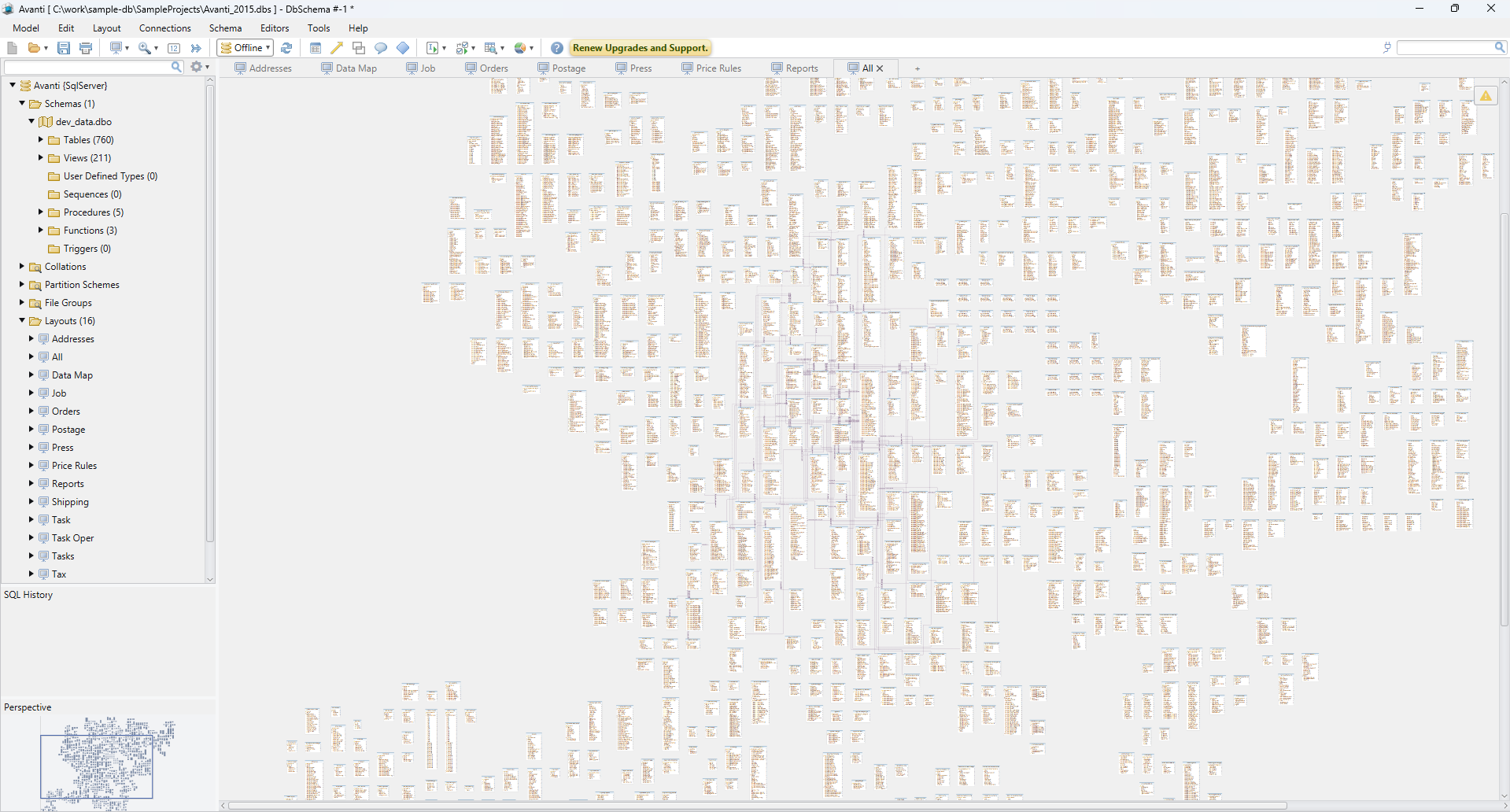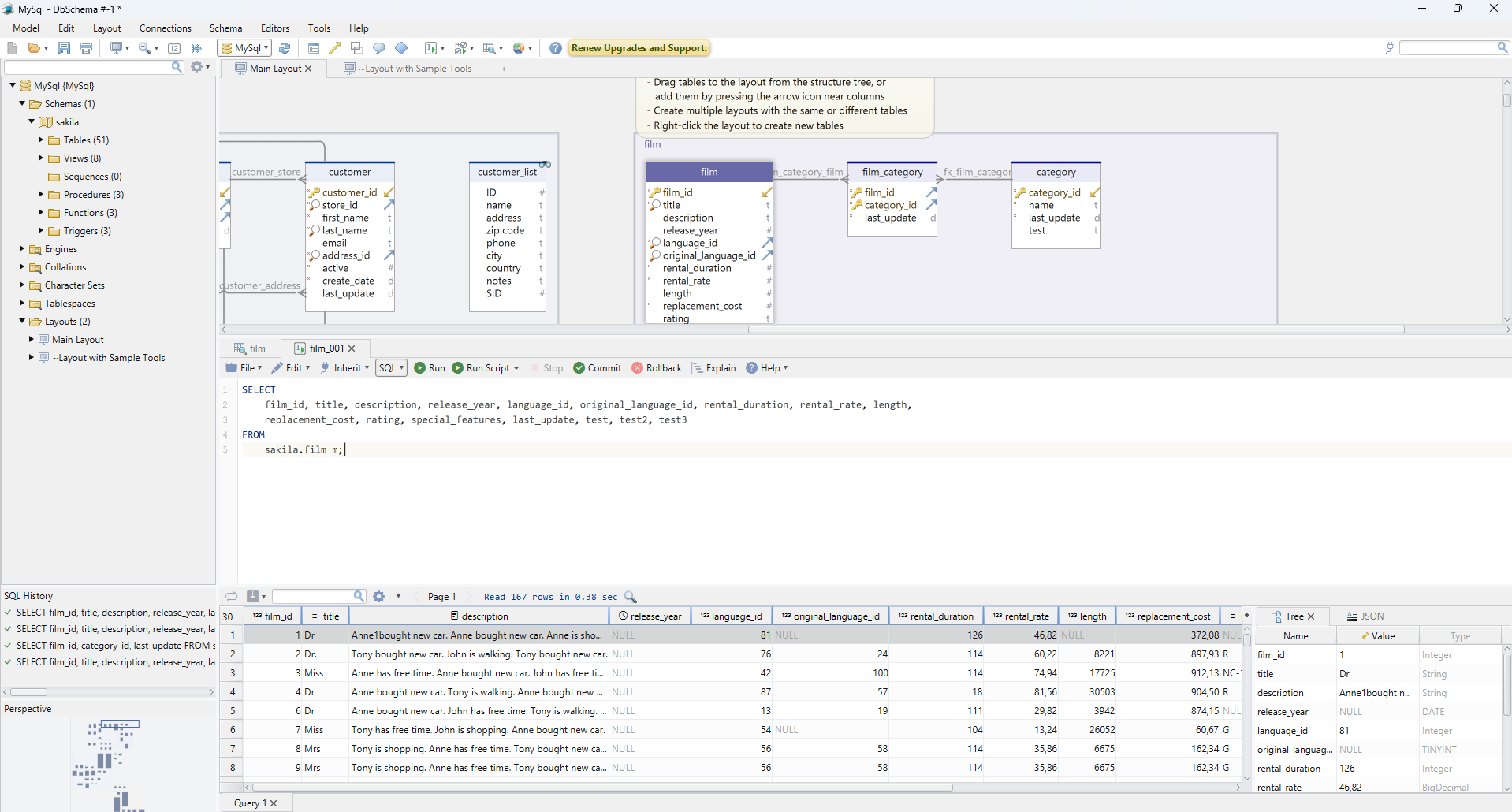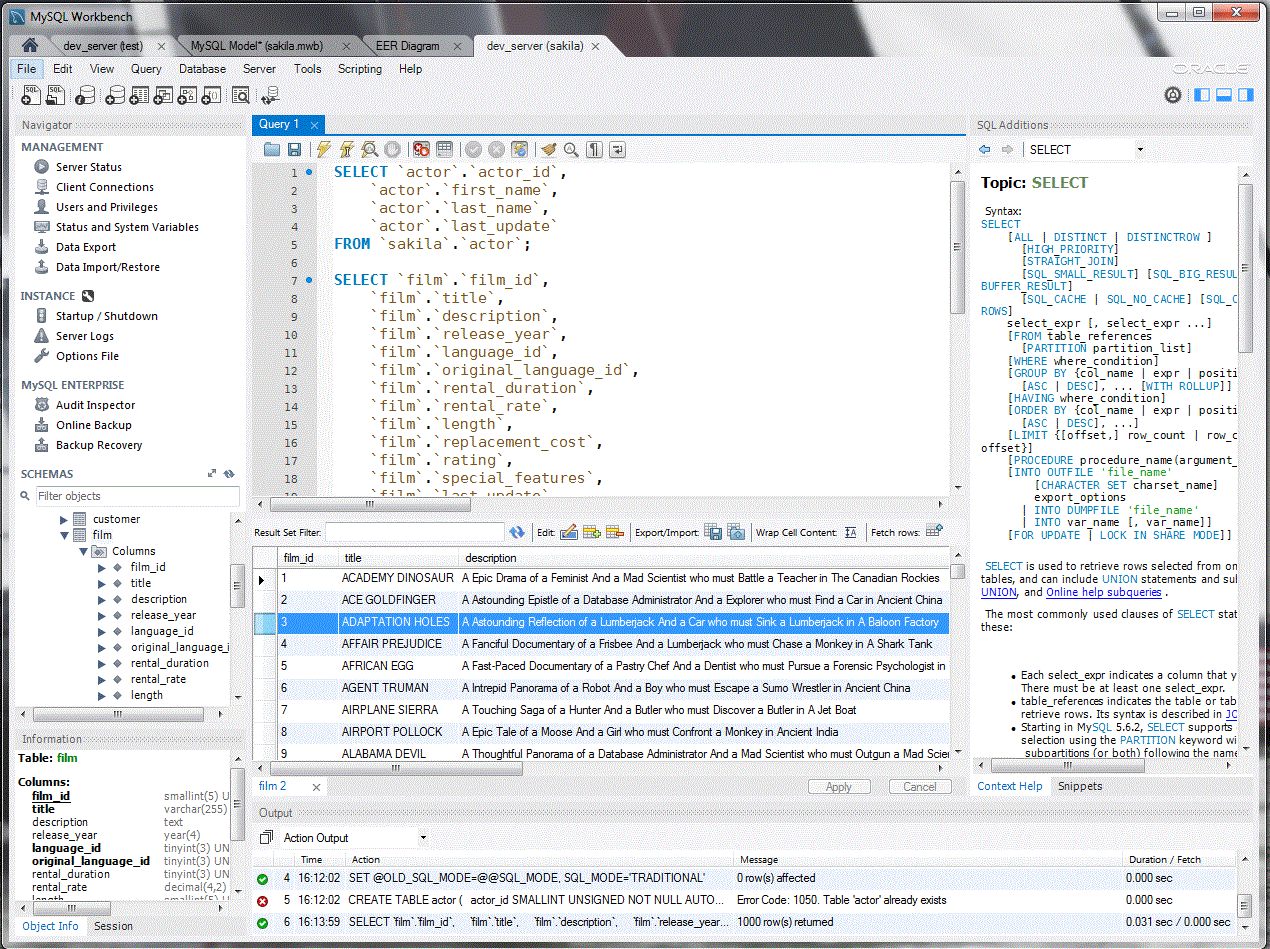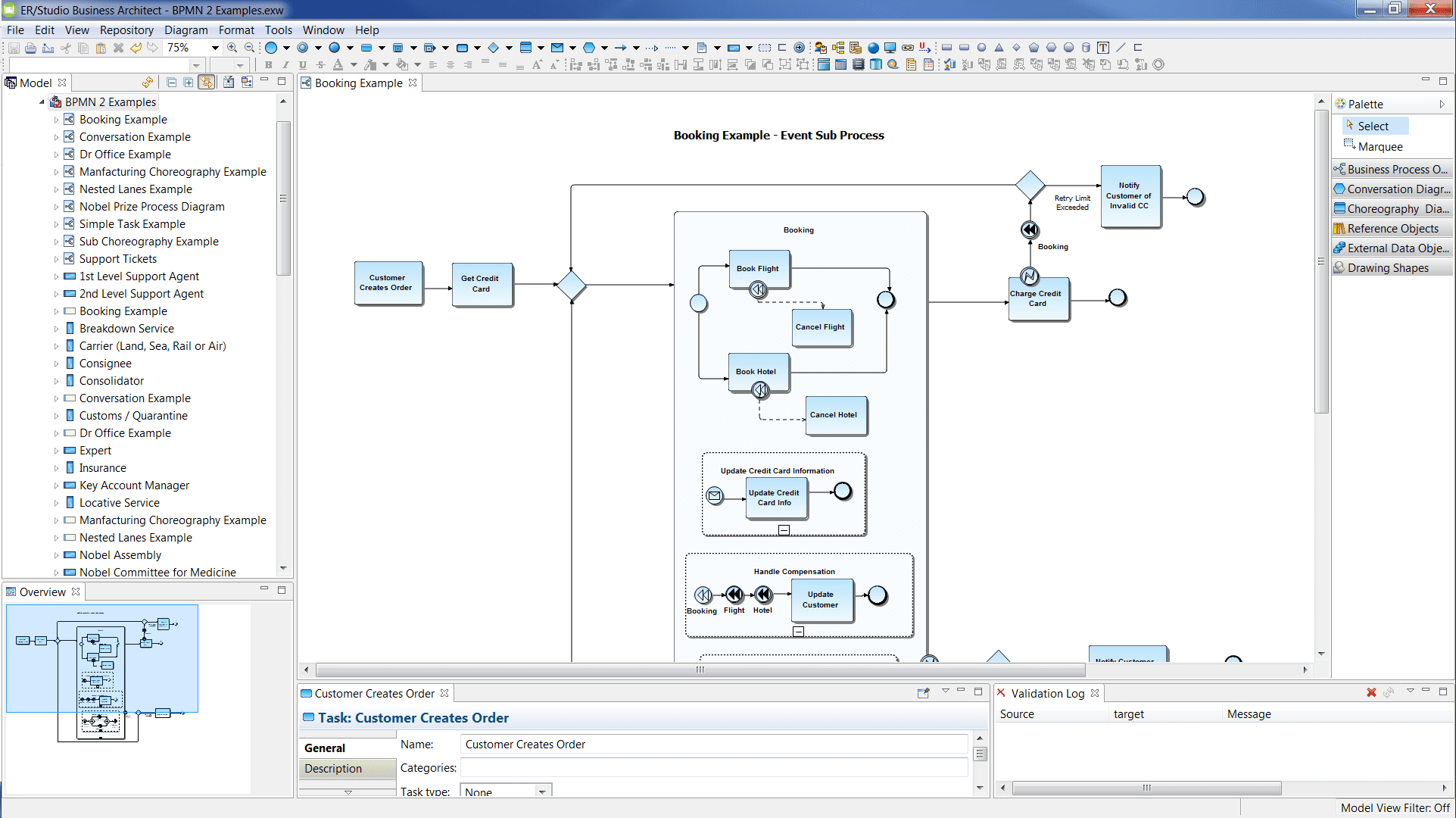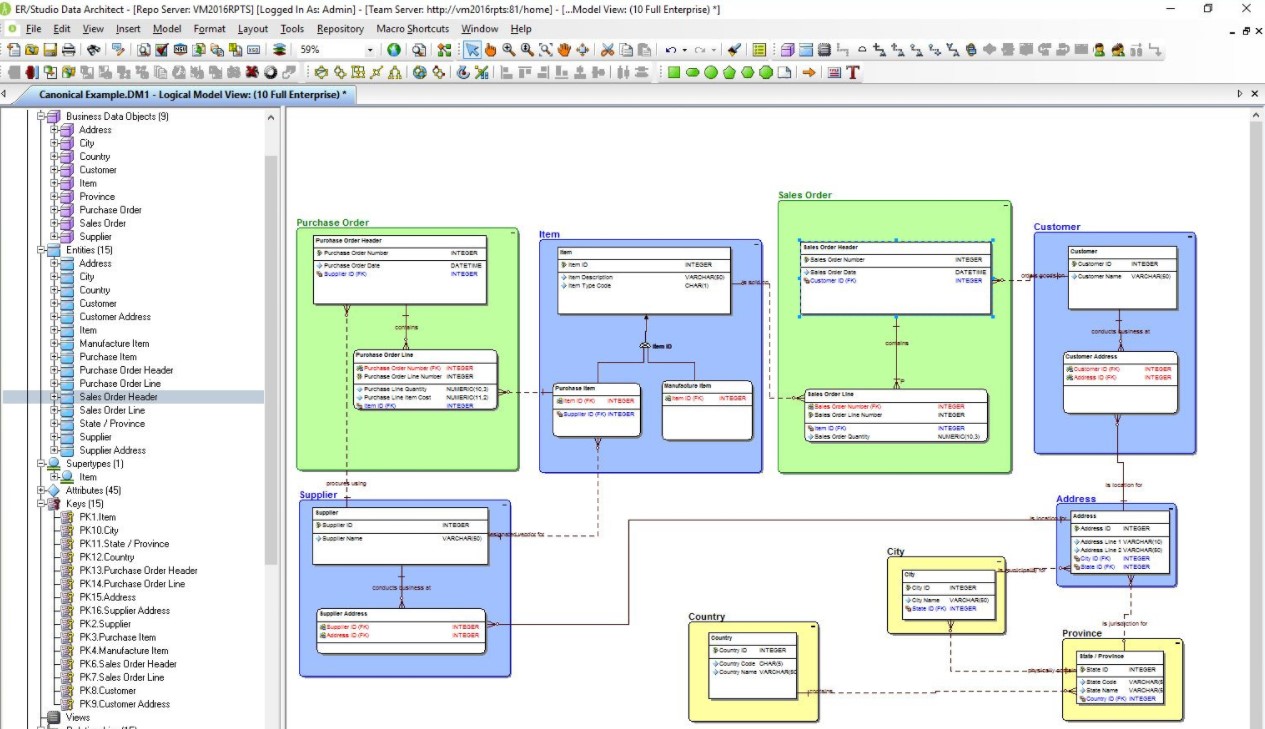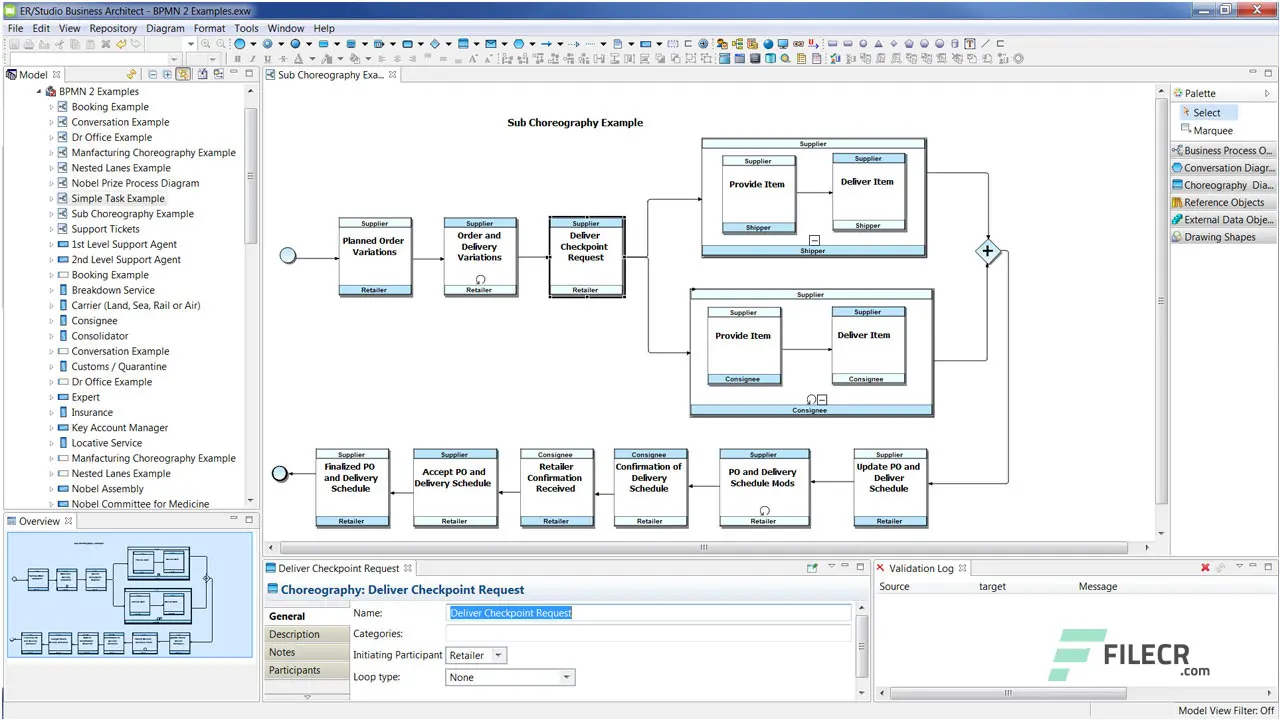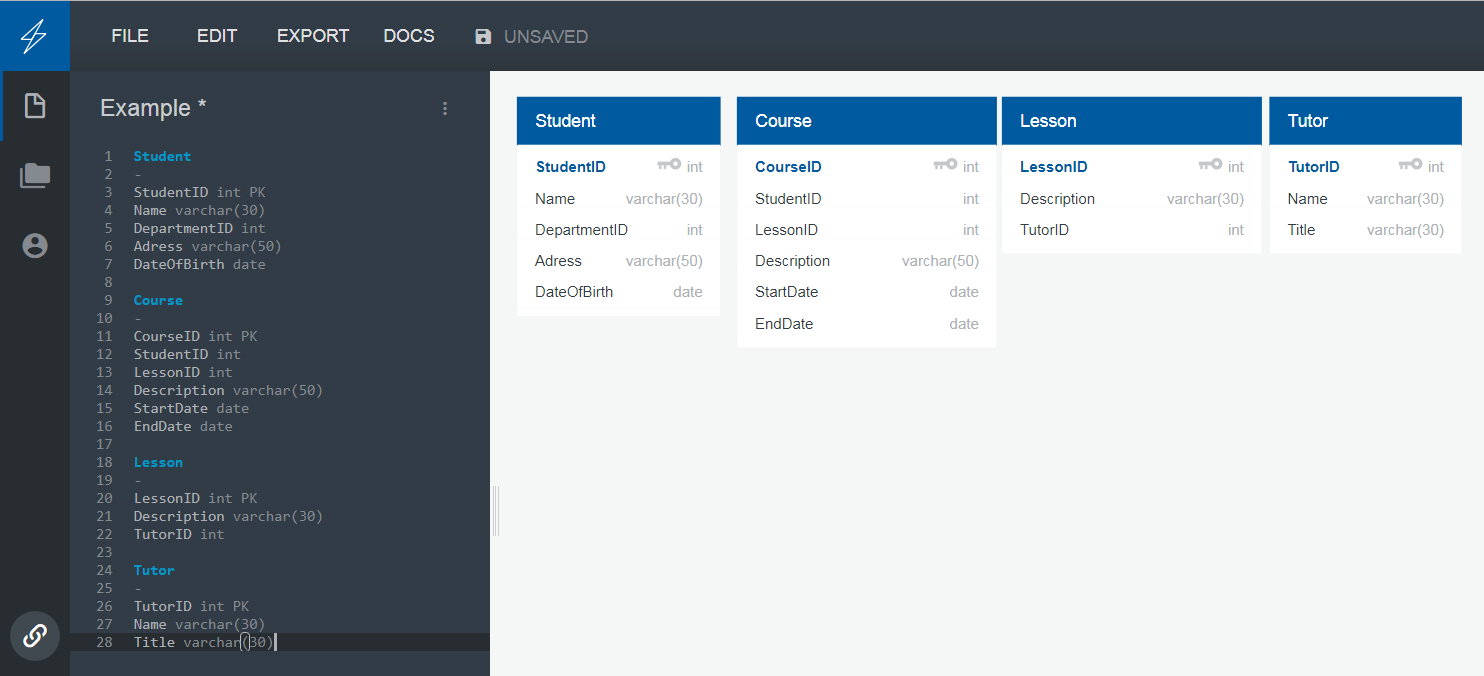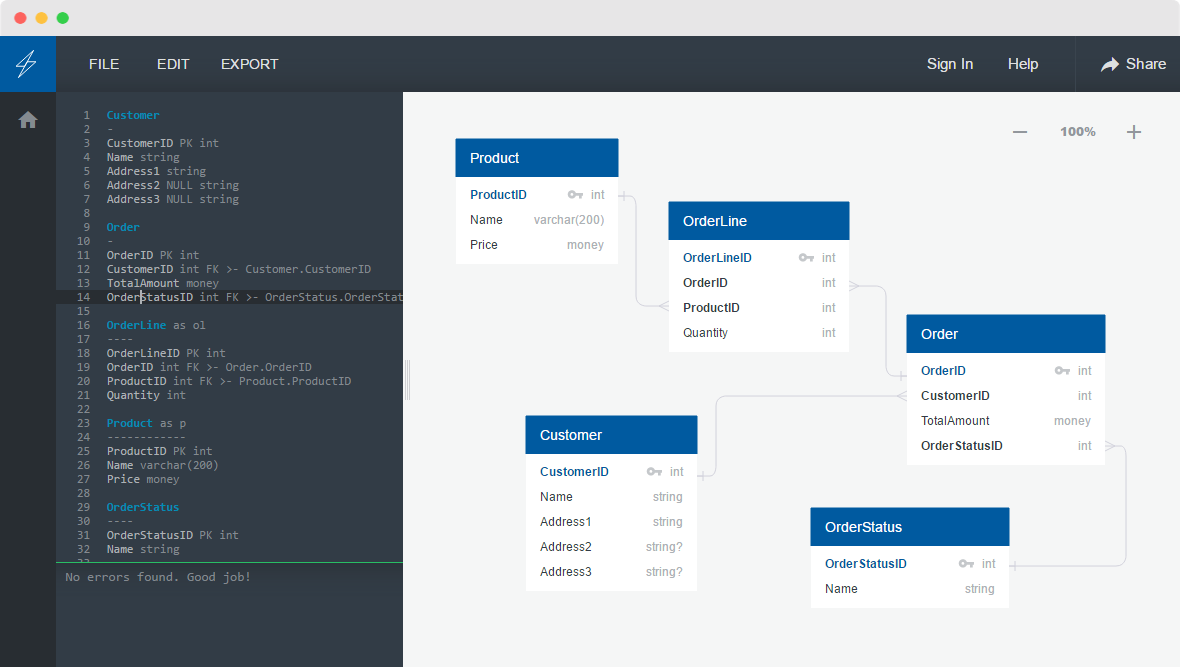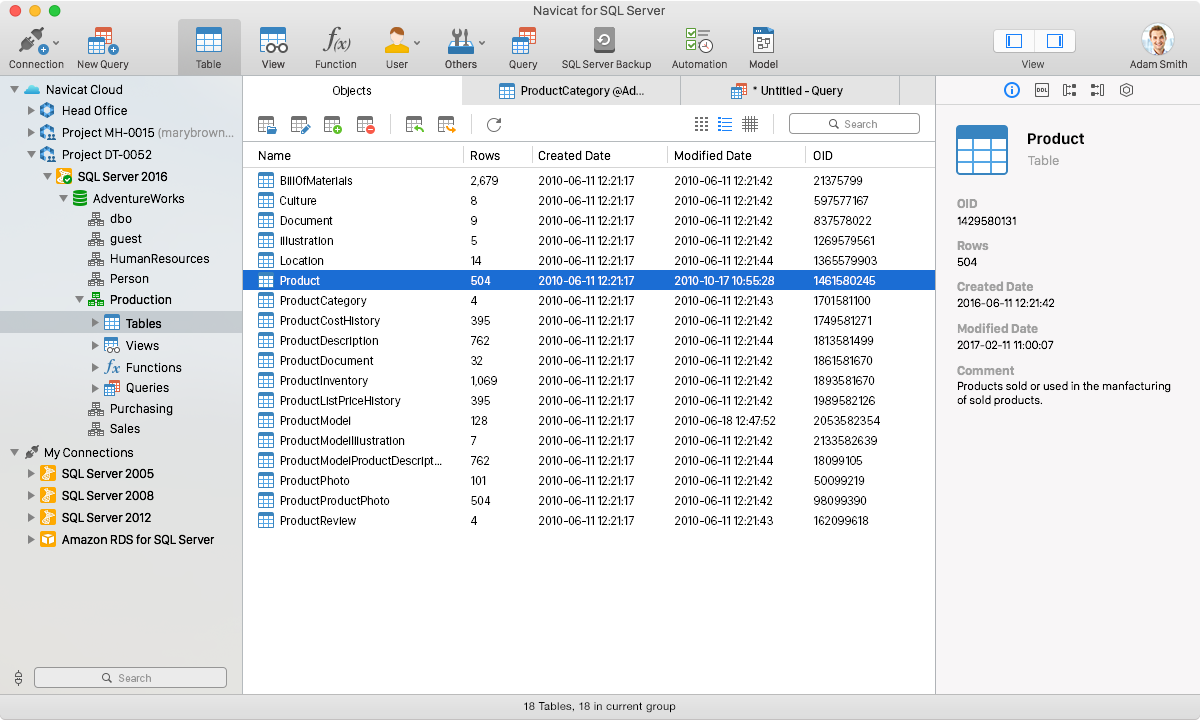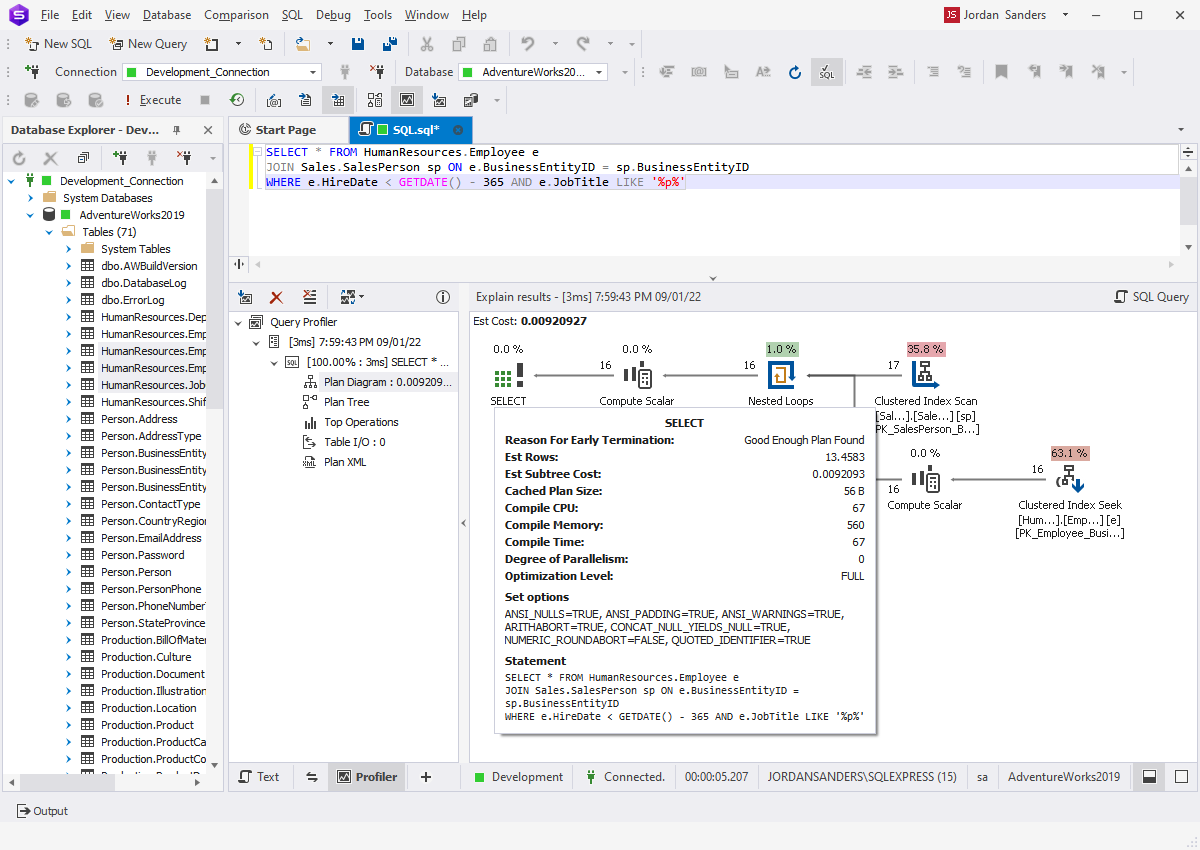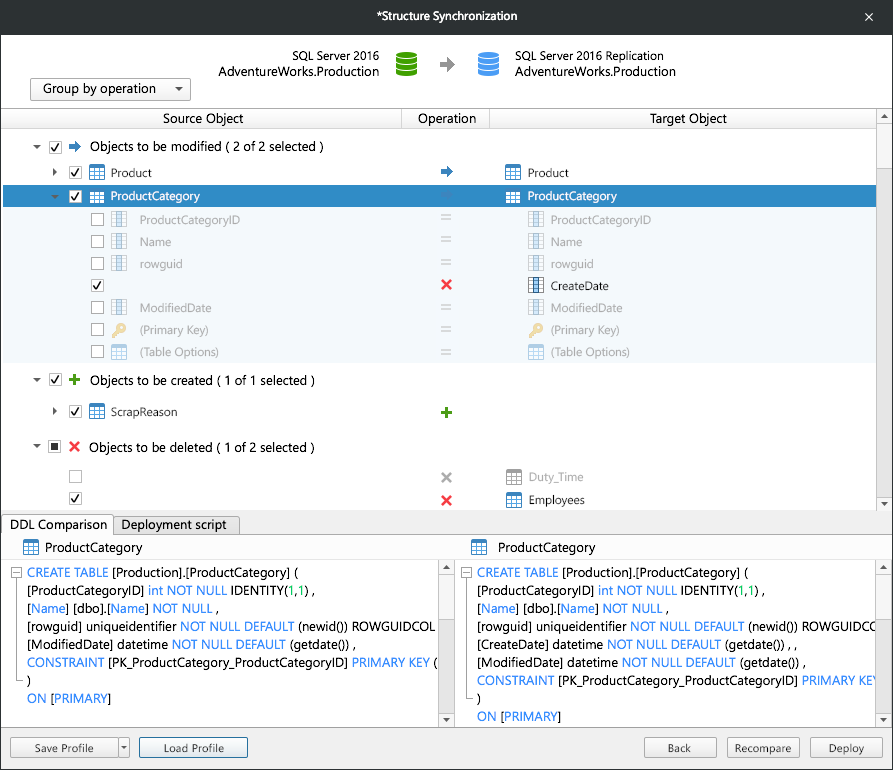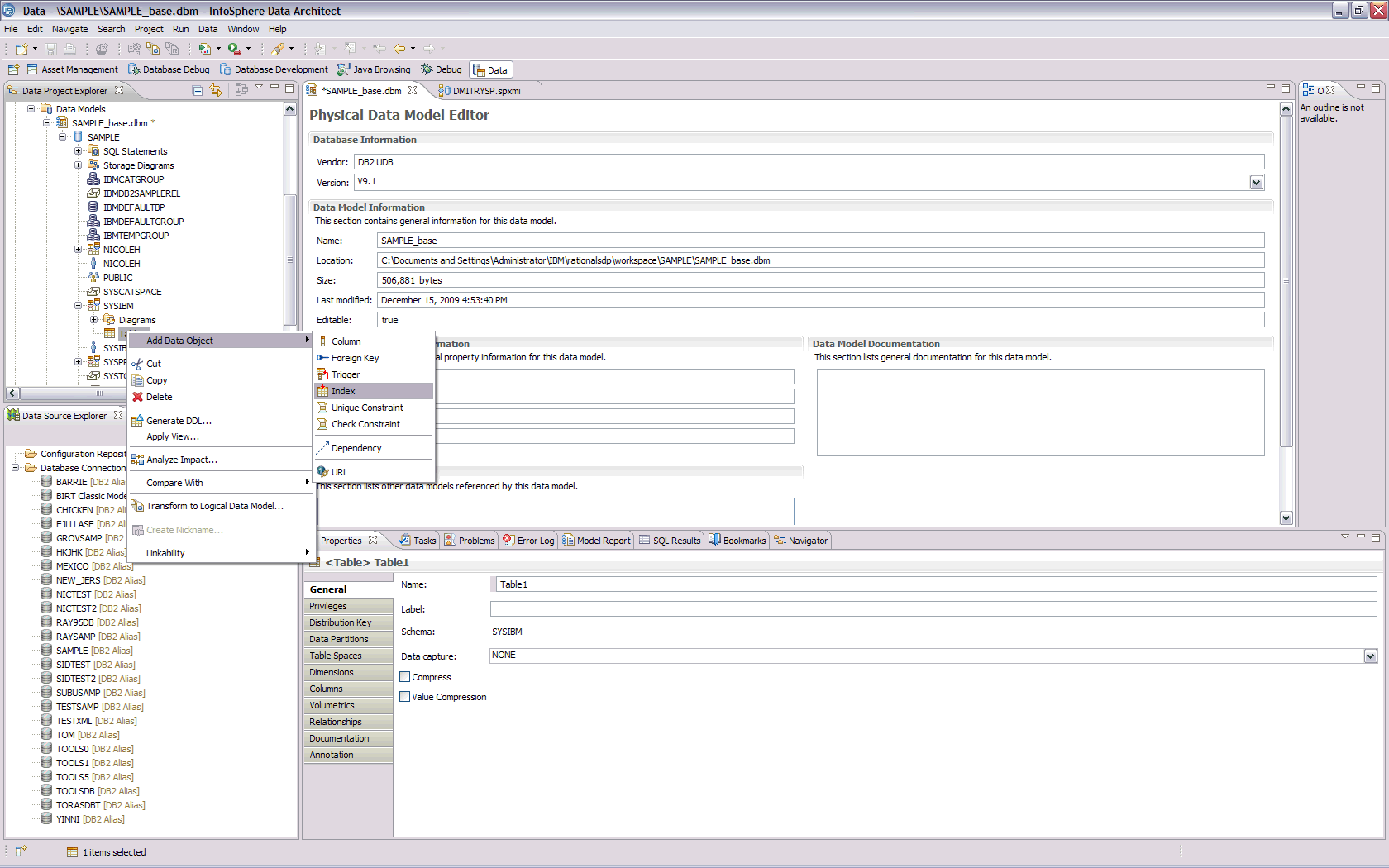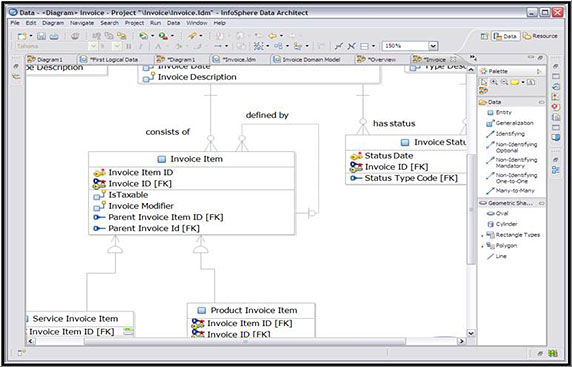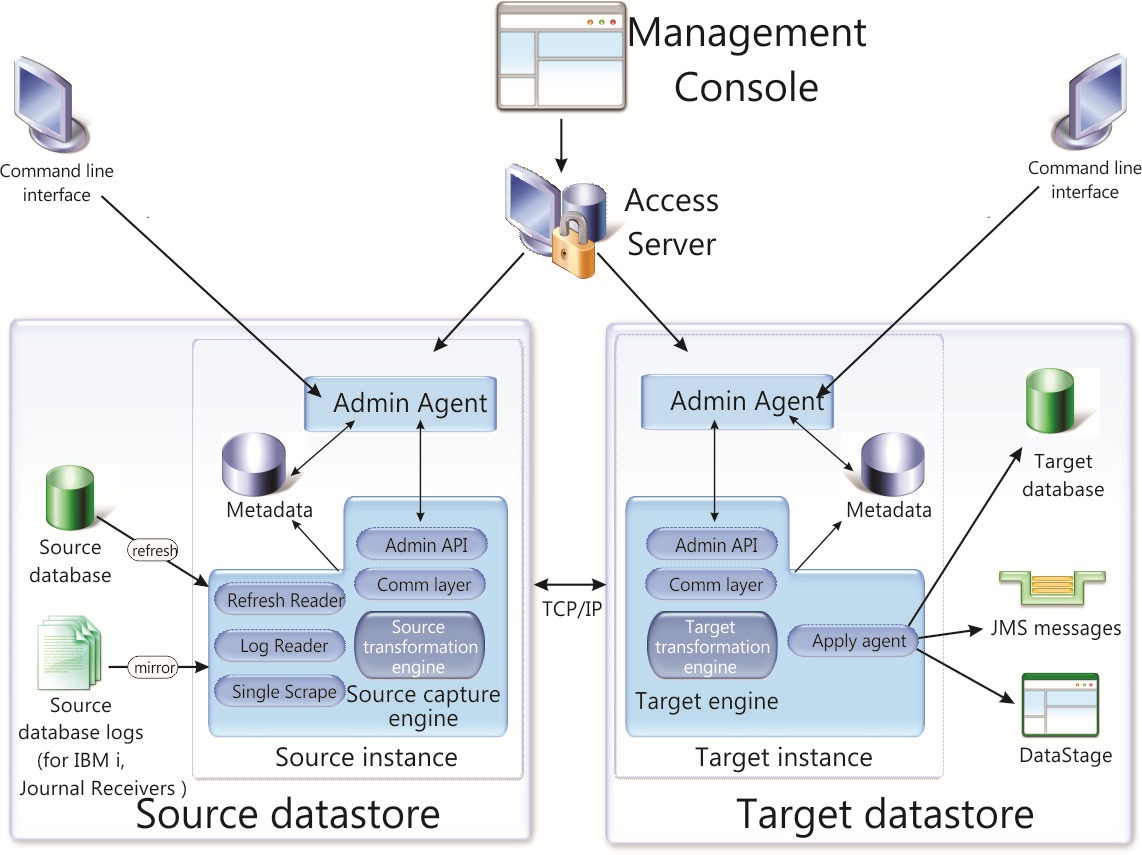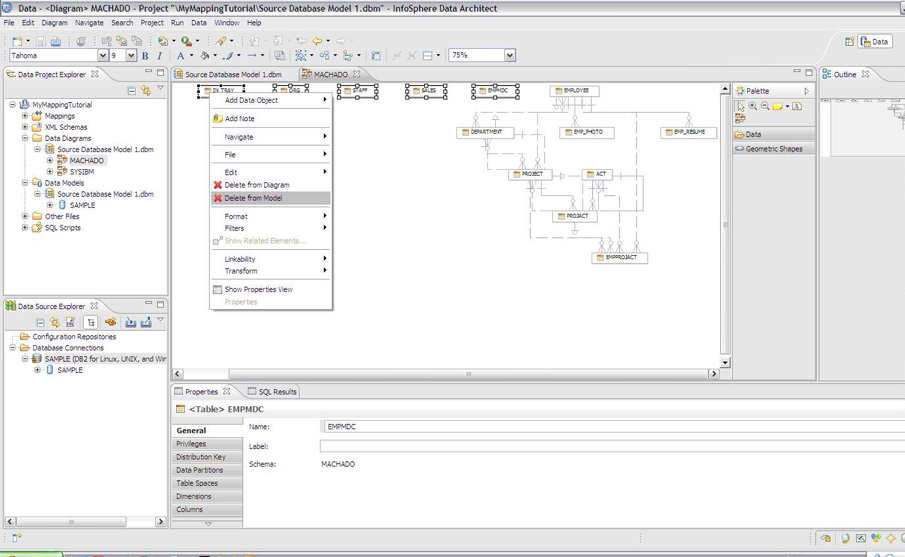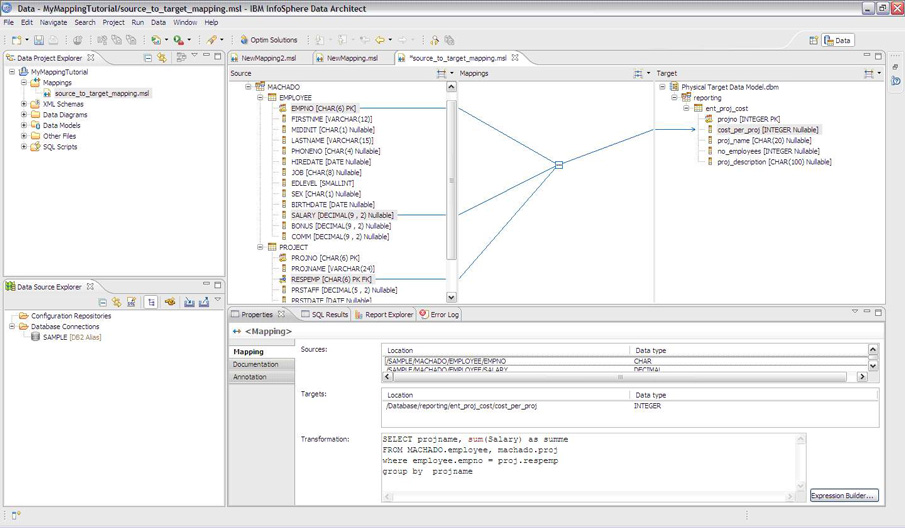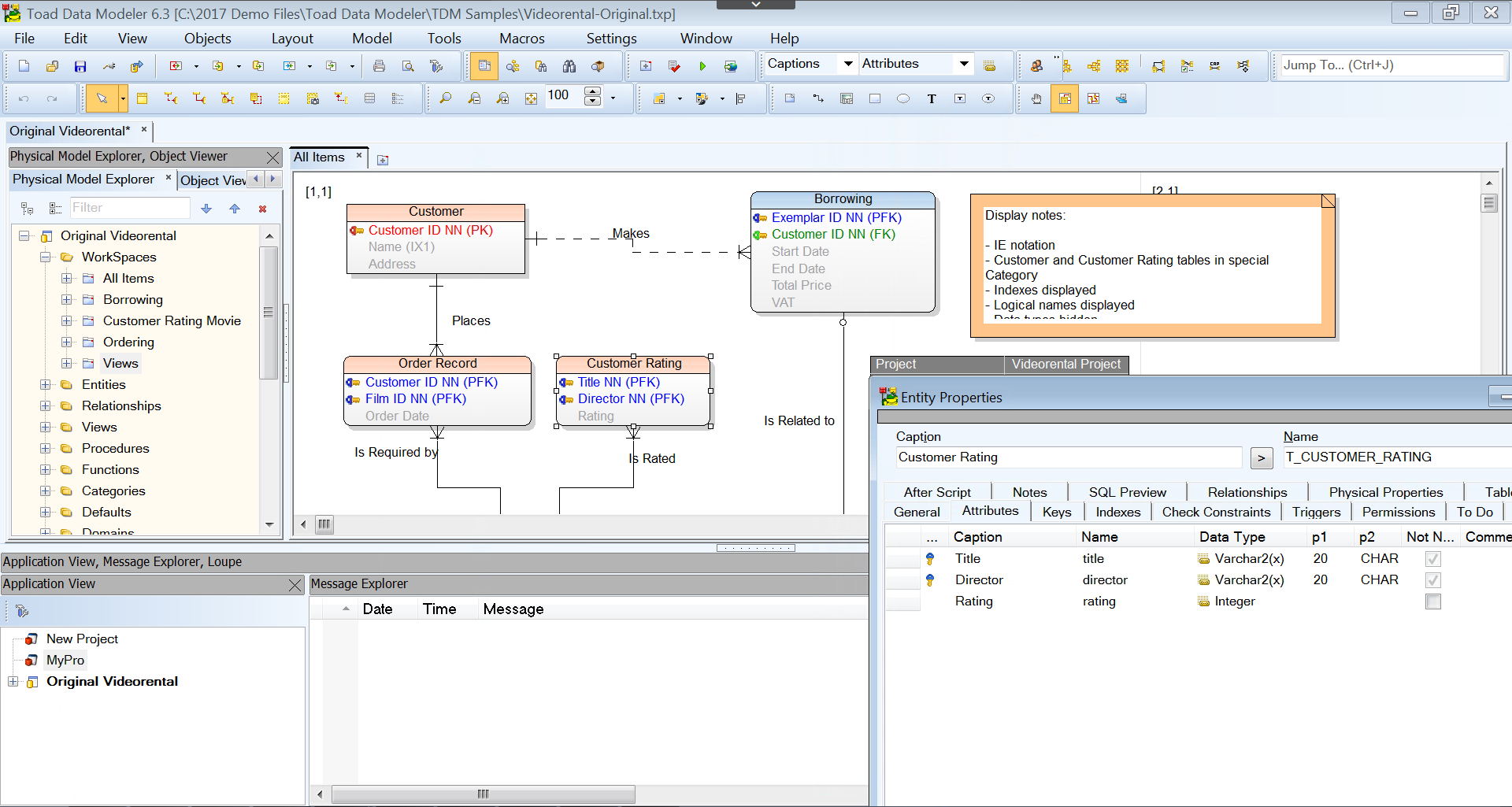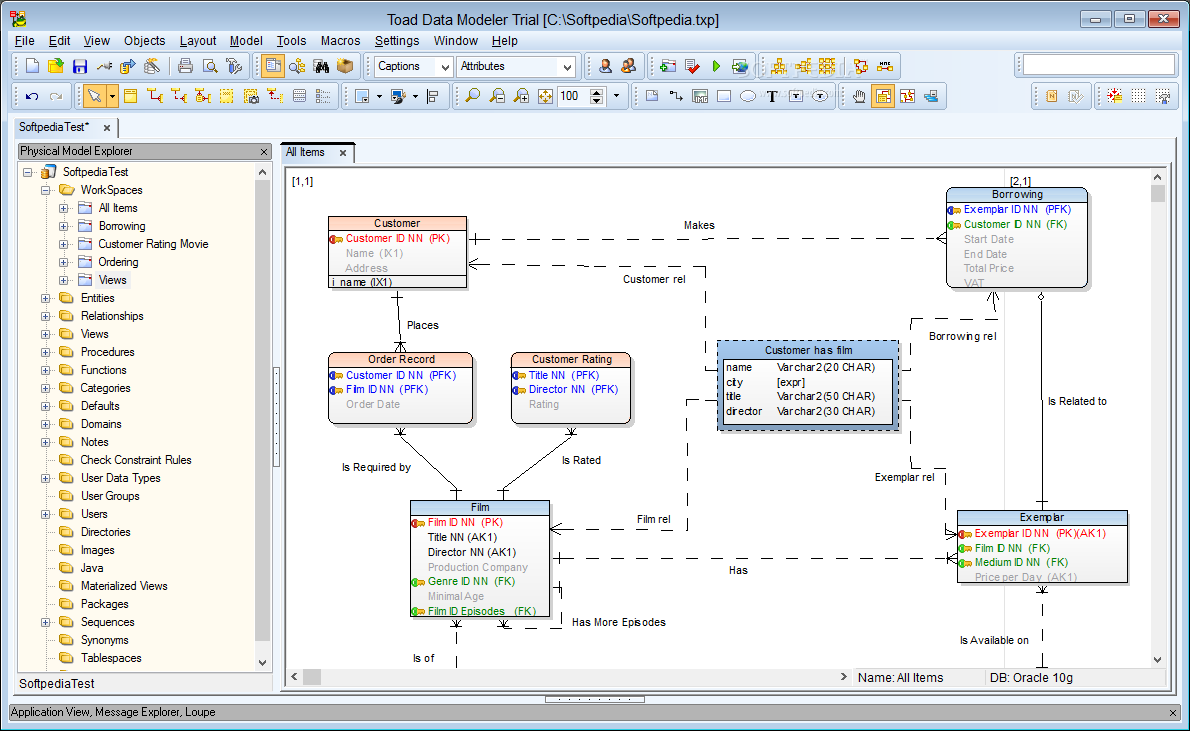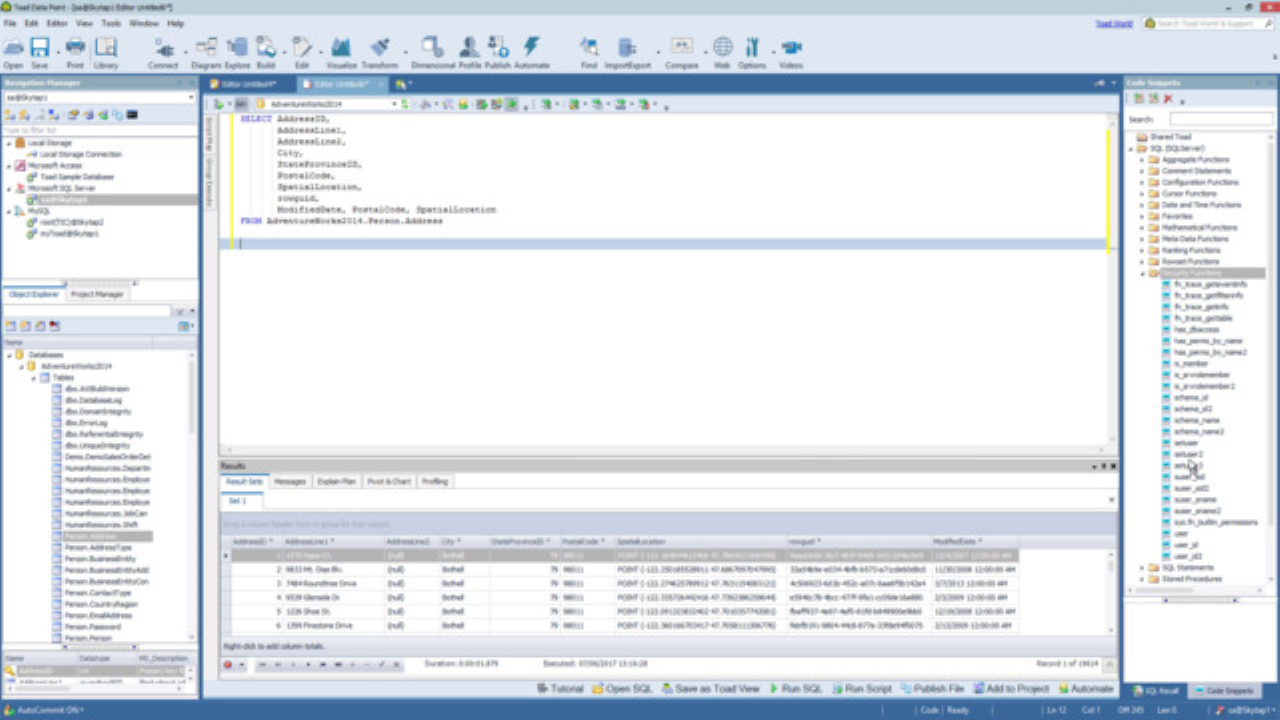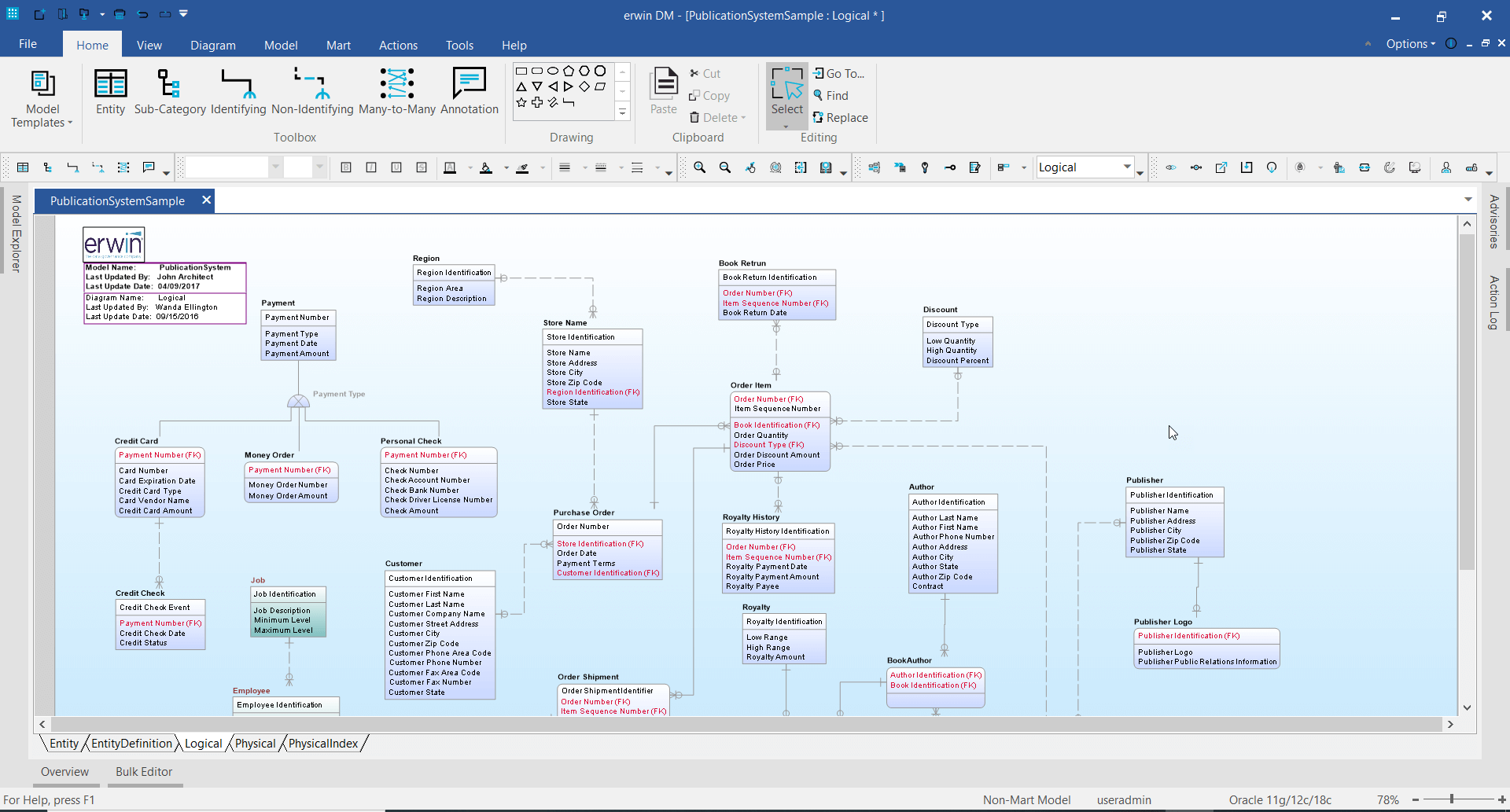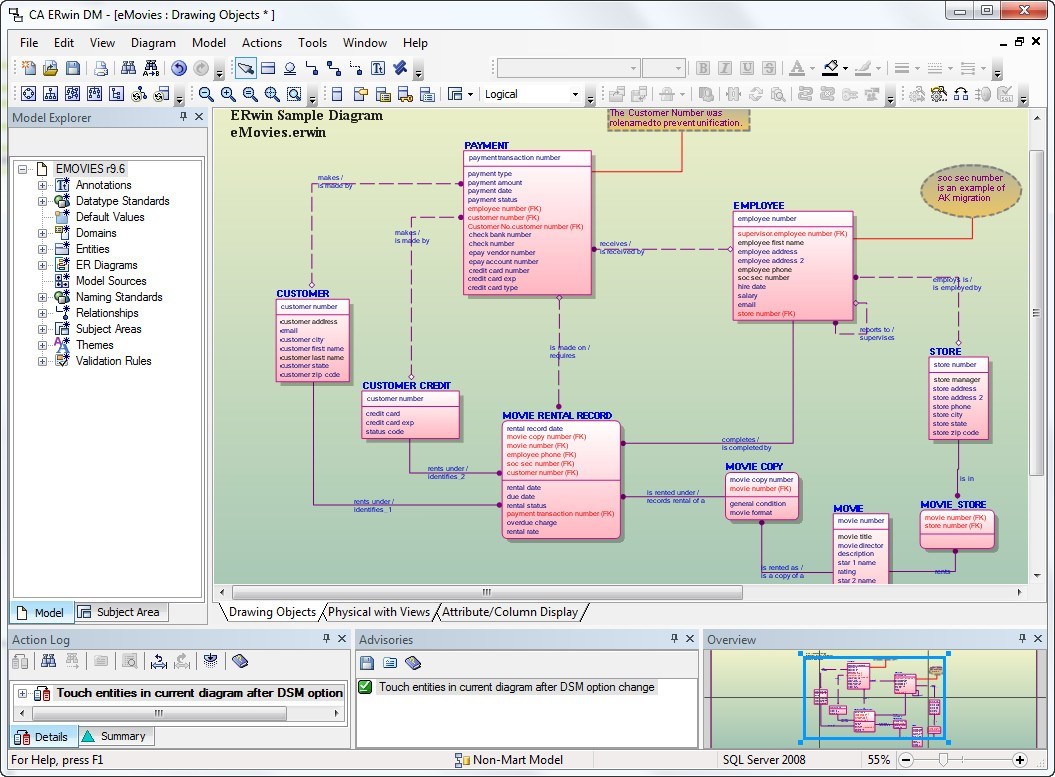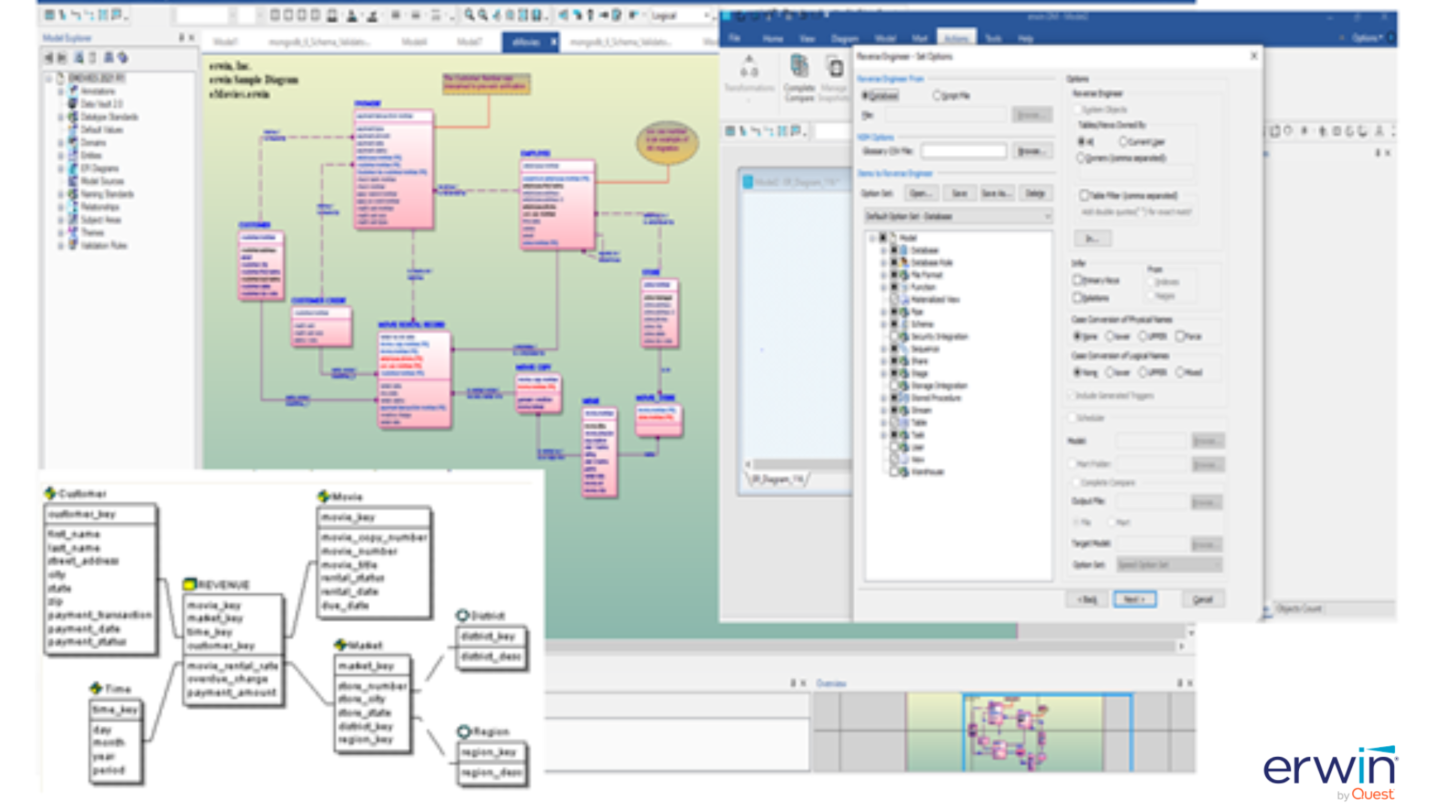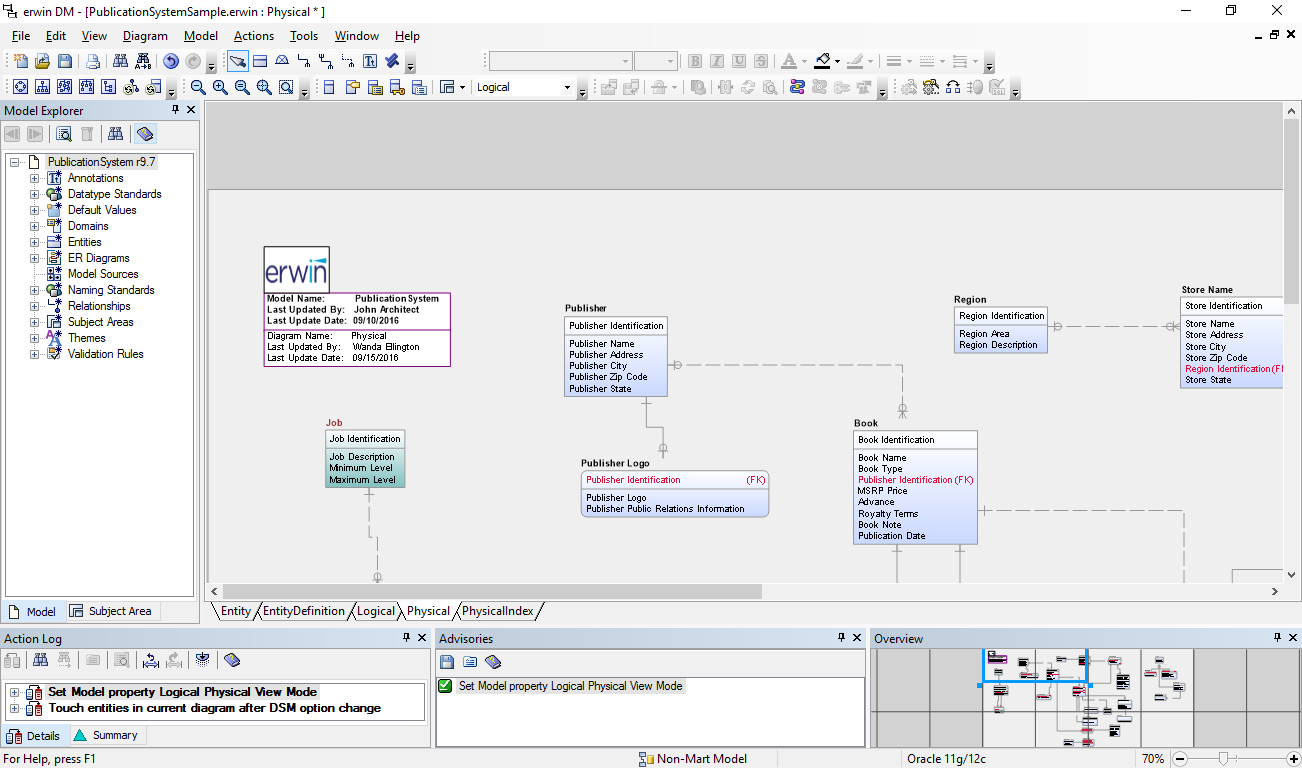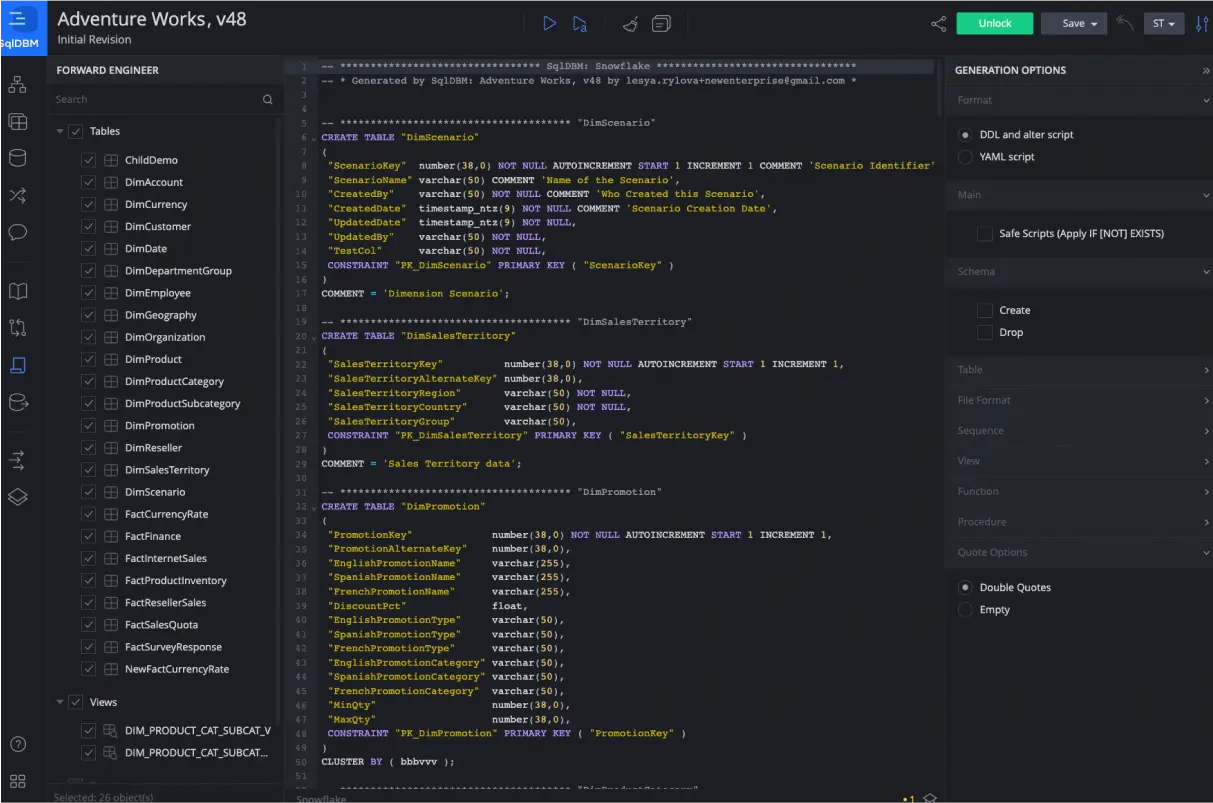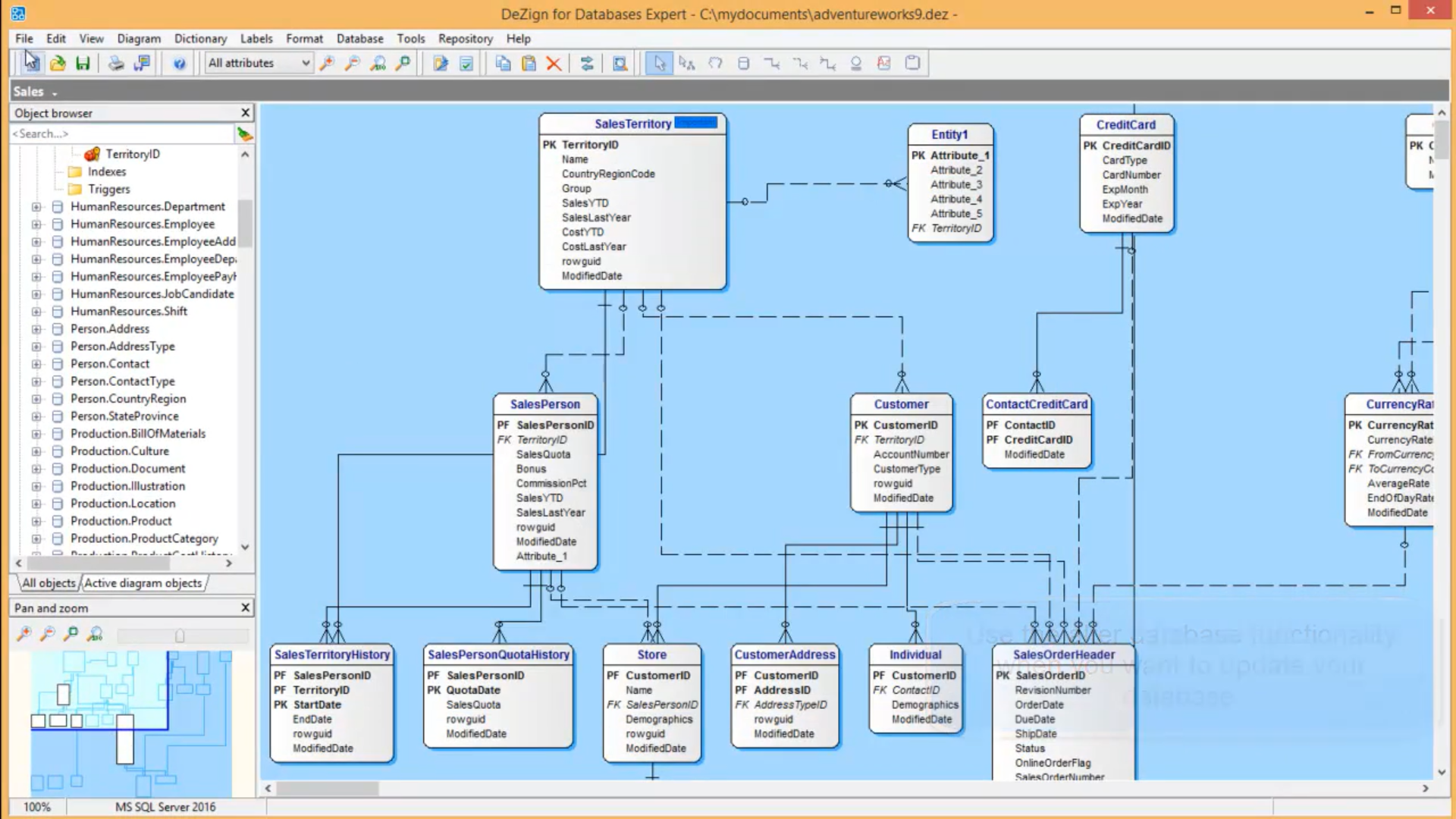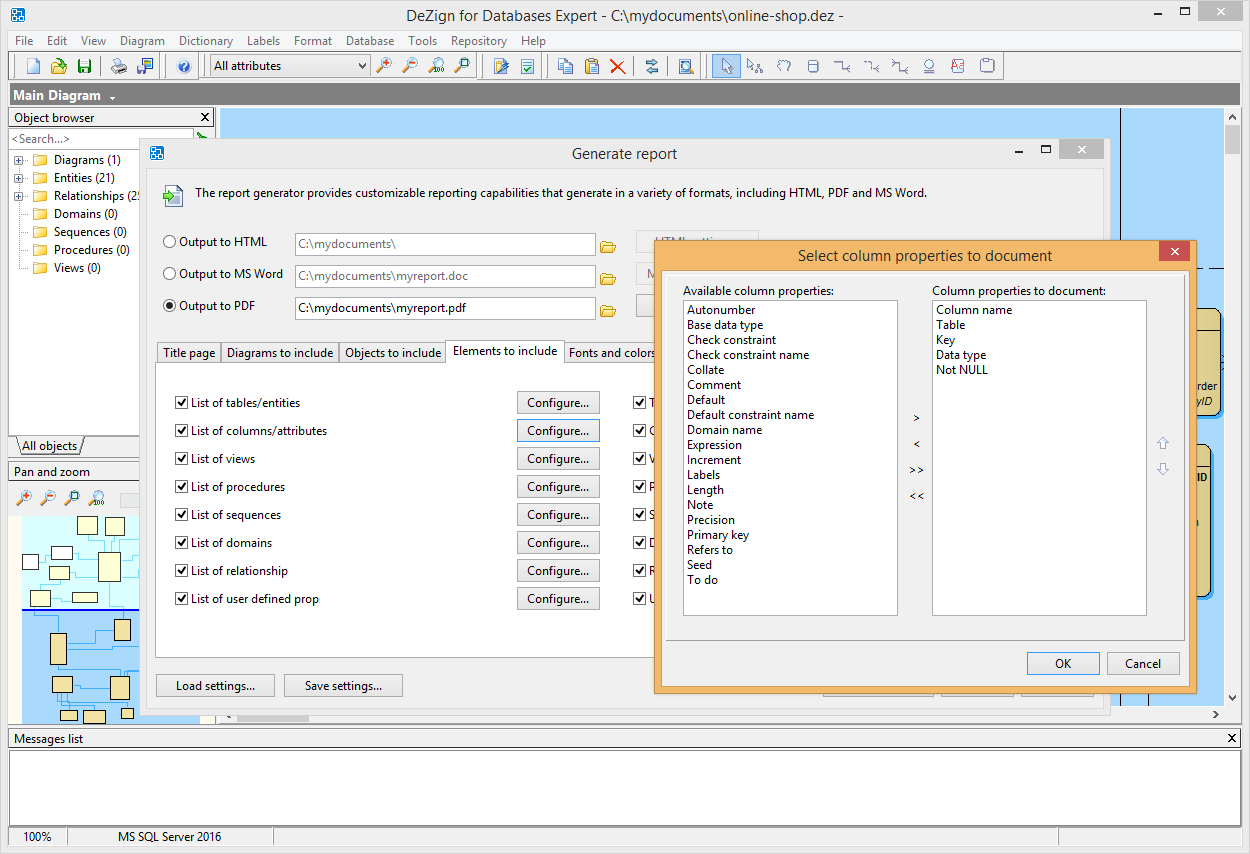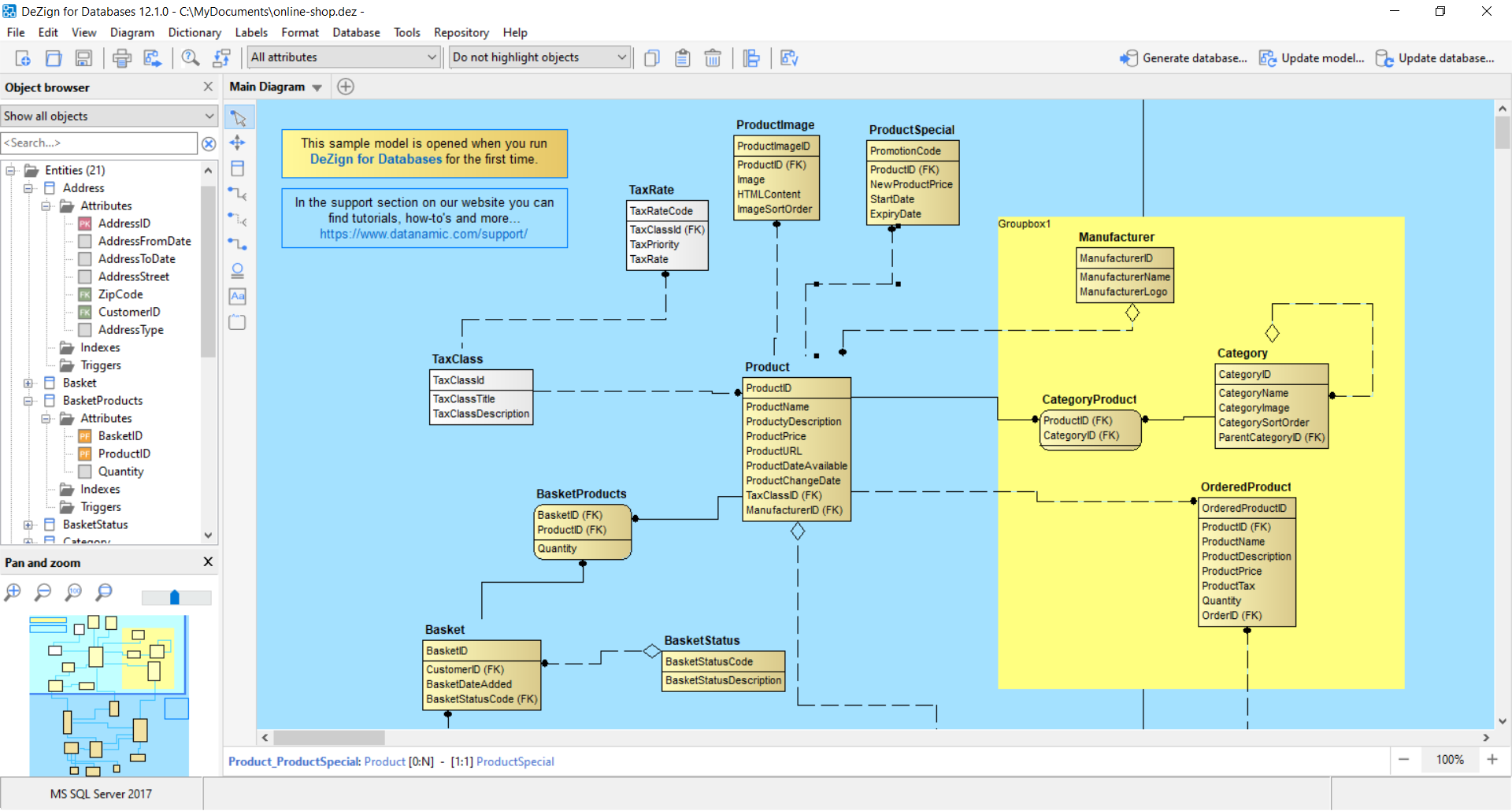What are Database Design Tools?
A database design tool is a software application used to design, create, and manage a database structure, or schema. These tools typically provide a graphical user interface (GUI) that allows users to visually create and manipulate database tables, relationships, constraints, and other database elements.
General Requirements
These tools allow you to visually design your database schema using Entity-Relationship Diagrams (ERDs) or other similar methods.
Forward engineering involves creating a database schema from a diagram, while reverse engineering involves generating a diagram from an existing database.
Database design tools can help you model data, define relationships between tables, and ensure normalization of data.
They can help synchronize the database design with the actual database, whether applying changes from the design to the database (forward engineering) or updating the design based on changes in the database (reverse engineering).
Many of these tools can auto-generate SQL scripts based on the database design, which can then be run on the database management system to create or alter the actual database.
These tools can check your database design for common errors or inefficiencies, such as missing indexes or potential violation of normalization rules.
Our Favorite Tools
DbSchema Database Designer
Website: https://dbschema.com
DbSchema is a visual database design and management tool. It provides a comprehensive solution for designing, documenting, and interacting with databases of various types, including relational databases, MongoDB, Cassandra, and more. DbSchema allows users to visually create and edit database schemas using interactive diagrams, simplifying the design process. It also offers features such as data exploration, query building, data generation, data import/export, and HTML documentation generation. DbSchema supports multiple database platforms and provides a user-friendly interface to streamline database development and maintenance tasks.
DbSchema Features
DbSchema Pro provides a user-friendly and intuitive interface that simplifies database design, management, and documentation.
With DbSchema Pro, you can visually design and modify database schemas using interactive diagrams, making it easy to understand and modify the structure.
DbSchema Pro supports various database systems, allowing you to work with multiple databases seamlessly within a single tool.
DbSchema Pro offers schema synchronization capabilities, enabling you to compare and synchronize the database schema with the design model or other databases, ensuring consistency.
The built-in Query Builder simplifies query creation by providing a visual interface, allowing you to build complex queries with ease.
DbSchema Pro allows you to import and export data from various file formats, such as CSV, Excel, and XML, enabling seamless data integration and migration.
With DbSchema Pro, you can visually explore and analyze data from multiple tables and collections, making it easier to understand relationships and patterns.
DbSchema Pro generates comprehensive HTML5 documentation that includes interactive diagrams, providing a clear and organized overview of the database structure.
DbSchema Pro supports collaboration by allowing team members to work together on the same design model, making it easier to collaborate and share changes.
DbSchema Pro offers automation and scripting capabilities, allowing you to automate repetitive tasks and customize database management workflows.
Operating System:
Licensing:
MySql Workbench
Website: https://www.mysql.com/products/workbench/
MySQL Workbench is an official, integrated development environment (IDE) provided by MySQL for database design, development, administration, and management. It is a visual tool that offers a range of features to streamline MySQL database-related tasks.
MySqlWorkbench Features
MySQL Workbench provides a visual interface for designing and modeling databases. It allows users to create, modify, and manage database schemas using a graphical representation of tables, relationships, and entities. It supports the creation of entity-relationship (ER) diagrams and provides tools for forward and reverse engineering of database structures.
MySQL Workbench offers a comprehensive SQL editor with syntax highlighting, code completion, and formatting capabilities. Users can write and execute SQL queries directly within the tool. It supports features like query execution history, query snippets, and parameterized queries.
MySQL Workbench includes administration tools for managing MySQL databases. It provides functionality for user management, server configuration, performance tuning, and server monitoring. Users can administer databases, tables, indexes, and stored procedures using the graphical interface.
MySQL Workbench supports data migration from various database systems to MySQL. It offers wizards and utilities for transferring data from different sources, including CSV files, SQL scripts, and other database systems. It provides options for importing and exporting data to and from MySQL databases.
MySQL Workbench includes tools for performance analysis and optimization. It allows users to monitor and profile database queries, examine execution plans, and identify performance bottlenecks. It offers query optimization suggestions and helps optimize database performance.
MySQL Workbench provides functionalities for creating and restoring database backups. Users can schedule automated backups, manage backup files, and restore databases to previous states.
MySQL Workbench supports collaborative database development by allowing multiple users to work on the same database model or SQL scripts simultaneously. It also integrates with version control systems like Git, enabling developers to manage and track changes to their database-related files.
Operating System:
Licensing:
Idera ER/Studio
Website: https://www.idera.com/products/er-studio/enterprise-data-modeling/
IDERA ER/Studio is a powerful suite of data modeling tools that provides a collaborative environment for data management professionals to manage enterprise data architecture.
ERStudio Features
ER/Studio enables users to visually design and maintain database structures at a high level from existing database schemas. The visual data models help in understanding complex databases and simplifying the design process.
ER/Studio supports a wide range of databases including SQL Server, Oracle, MySQL, PostgreSQL, and more.
ER/Studio allows users to generate databases from a model (forward engineering) as well as create models from an existing database (reverse engineering).
ER/Studio provides model validation capabilities, ensuring the models adhere to best practices and business rules.
ER/Studio's collaborative features allow multiple users to work on data models simultaneously. It also provides version control to manage and track changes.
ER/Studio's common data dictionary ensures consistent naming conventions and data attributes across all data models.
ER/Studio allows for the integration of business glossaries and other metadata with data models to improve data governance and understanding.
Operating System:
Licensing:
QuickDatabaseDiagrams
Website: https://dbdiagram.io/home
QuickDatabaseDiagrams is an online tool for creating professional database diagrams quickly and easily. It provides a user-friendly interface that allows users to design, visualize, and document their database structures using an intuitive drag-and-drop approach.
QuickDatabaseDiagrams Features
Users can create entity-relationship diagrams (ERDs) by dragging and dropping tables onto the canvas and defining relationships between them. The tool supports different notations, including crow's foot notation and Chen notation.
QuickDatabaseDiagrams focuses on simplicity and speed, allowing users to create database diagrams rapidly without complex configuration or excessive manual input.
Users can collaborate with team members by sharing the diagram through a shareable link. This enables real-time collaboration, allowing multiple users to work on the same diagram simultaneously.
QuickDatabaseDiagrams allows users to export diagrams in various formats, including PNG, PDF, and SQL. Users can also generate documentation for their database structure, capturing the table details, column attributes, and relationships.
The tool provides version control capabilities, allowing users to track changes made to the database diagram over time. Users can compare different versions, revert to previous versions, and leave comments for collaboration purposes.
Operating System:
Licensing:
Navicat
Website: https://navicat.com/en/
Navicat is a powerful, graphical database management and development tool. It offers a comprehensive set of features for managing, querying, and designing databases. Navicat supports various database systems, making it a versatile tool for working with different database platforms.
Navicat Features
Navicat supports a wide range of database systems, including MySQL, PostgreSQL, Oracle, SQL Server, SQLite, and more. It allows users to connect to multiple databases simultaneously, making it convenient for cross-database management and data transfer.
Navicat provides a user-friendly interface for managing databases. Users can create, edit, and delete database objects such as tables, views, indexes, and stored procedures. It also allows users to modify database settings, manage user accounts, and perform database backup and restore operations.
Navicat offers an advanced SQL editor with syntax highlighting, code completion, and formatting capabilities. Users can write and execute SQL queries, view query results, and manipulate data within tables. It supports importing and exporting data in various formats and provides tools for data synchronization and data transfer between databases.
Navicat includes a visual database design tool that allows users to create and modify database schemas using a graphical interface. It supports entity-relationship (ER) diagrams and provides features for visually designing tables, relationships, and constraints. The tool can generate SQL scripts based on the designed schema for easy deployment.
Navicat offers data modeling capabilities that enable users to create and manage data models. It allows for forward and reverse engineering, making it possible to generate ER diagrams from existing databases and vice versa. Users can visualize database structures, relationships, and dependencies.
Navicat provides functionalities for transferring and synchronizing data between different databases. Users can migrate data from one database system to another, perform data synchronization between databases, and schedule automated data transfer tasks.
Navicat supports collaboration among team members working on databases. It provides features for sharing and syncing connection settings, query snippets, and data models. Team members can collaborate on database development and share information seamlessly.
Navicat supports secure connections to databases using SSL/TLS encryption. It ensures data security during data transmission between the tool and the connected database.
Operating System:
Licensing:
Power Designer
Website: https://www.sap.com/products/technology-platform/powerdesigner-data-modeling-tools.html
PowerDesigner is a leading data modeling and metadata management tool developed by SAP. It is widely used in enterprise environments for designing, analyzing, and documenting various aspects of information systems. PowerDesigner supports multiple modeling techniques, including entity-relationship (ER) modeling, UML modeling, data warehouse modeling, and more. With PowerDesigner, users can create conceptual, logical, and physical models of databases, as well as visualize and define relationships between entities and data elements. It provides a range of features for data modeling, such as reverse engineering existing databases, forward engineering to generate SQL scripts or DDL statements, and generating comprehensive documentation. PowerDesigner offers collaboration capabilities, allowing multiple users to work on models simultaneously and track changes through version control. It also integrates with other SAP products and technologies, enabling seamless integration within the SAP ecosystem. Beyond data modeling, PowerDesigner supports business process modeling, enterprise architecture, and data governance. It helps organizations align their business and IT strategies by capturing business requirements, analyzing dependencies, and ensuring consistency across different aspects of information systems. Overall, PowerDesigner is a comprehensive tool for data modeling and metadata management, empowering organizations to design and manage complex data structures, optimize database performance, and enhance the overall quality of their information systems.
PowerDesigner Features
PowerDesigner provides a comprehensive set of tools for creating and managing data models. It supports various modeling techniques such as entity-relationship (ER) modeling, UML modeling, data warehouse modeling, and more.
You can reverse engineer existing databases to generate data models in PowerDesigner. This feature allows you to analyze and document the structure of existing databases, enabling better understanding and management of data assets.
PowerDesigner enables you to forward engineer data models into physical databases. It can generate SQL scripts or DDL statements that can be executed to create database objects based on the defined data model.
The tool offers extensive capabilities for generating comprehensive documentation for data models. You can create documentation in various formats such as HTML, PDF, or Microsoft Word, providing clear and organized information about the data structures and relationships.
PowerDesigner supports collaboration among multiple users working on the same data models. It provides features for managing concurrent access, tracking changes, and merging modifications made by different team members. Version control integration allows for efficient management of model versions and history.
PowerDesigner includes features for business process modeling (BPMN) and business process analysis. It allows you to model, analyze, and optimize business processes, enabling better alignment between business requirements and IT systems.
PowerDesigner supports enterprise architecture modeling, allowing you to create and manage architecture models, define relationships between different architectural components, and visualize the impact of changes on the overall system.
The tool provides capabilities for tracking data lineage and performing impact analysis. This helps in understanding how data flows within the system, identifying dependencies, and assessing the impact of changes on data assets.
PowerDesigner seamlessly integrates with other SAP products and technologies, such as SAP HANA, SAP BW/4HANA, and SAP Solution Manager. This allows for better integration within the SAP ecosystem and enhanced interoperability with SAP systems.
Operating System:
Licensing:
IBM Info Sphere Data Architect
Website: https://www.ibm.com/products/infosphere-data-architect
IBM InfoSphere Data Architect (IDA) is a collaborative data design solution to help discover, model, relate, standardize, and integrate diverse and distributed data assets. It's part of IBM's InfoSphere initiative and is used by Data Architects and Business Analysts. The tool supports logical and physical data modeling, and it can reverse engineer, generate, compare, and synchronize models and databases.
InfoSphere Features
IDA provides an environment for discovering, modeling, relating, and standardizing diverse and distributed data assets. It supports logical (conceptual and business), relational (logical and physical), and dimensional modeling.
IDA integrates with other IBM InfoSphere products for data governance, quality, and integration.
IDA supports a wide range of databases including DB2, Informix, Oracle, SQL Server, Sybase, and more.
IDA allows you to generate databases from a model (forward engineering) and create models from an existing database (reverse engineering).
You can compare and synchronize database schemas and models.
You can share data designs, models, and metadata across the enterprise, promoting collaboration between business and IT.
IDA integrates with IBM InfoSphere Business Glossary (a shared repository for defining and managing business terms and relationships), allowing business and technical terms to be used interchangeably.
Operating System:
Licensing:
Toad
Website: https://www.quest.com/products/toad-data-modeler/
Toad is a popular software tool primarily used for database management and development. It is developed by Quest Software and supports various relational database management systems (RDBMS) such as Oracle, Microsoft SQL Server, MySQL, and IBM DB2. Toad offers a comprehensive set of features to streamline database administration, development, and optimization tasks.
Toad Features
Toad provides an integrated development environment (IDE) for writing, debugging, and optimizing SQL and PL/SQL code. It includes features like code completion, syntax highlighting, and code refactoring to enhance productivity and code quality.
Toad offers a range of tools for database administration tasks such as user management, performance monitoring, space management, backup and recovery, and schema comparison.
Toad supports data modeling and provides features for creating and managing entity-relationship (ER) diagrams, forward and reverse engineering, and generating data model documentation.
Toad enables users to import and export data to and from databases using various formats, including CSV, Excel, and XML. It provides flexible options for data migration, data synchronization, and data integration.
Toad includes query tuning and optimization tools to help identify and resolve performance issues. It offers features such as query optimization advisor, SQL tuning, and explain plan visualization.
Toad provides features for team collaboration, allowing multiple developers to work on the same database objects and track changes. It supports version control integration and offers features like object compare and merge.
Toad allows users to automate repetitive tasks and create scripts for database administration and development activities. It provides a scripting language and scheduling capabilities to automate routine tasks and streamline workflows.
Operating System:
Licensing:
ERwin
Website: https://www.erwin.com/products/erwin-data-modeler/
ERwin, also known as erwin Data Modeler, is a popular data modeling tool used for designing, visualizing, and managing databases. It provides a comprehensive set of features and functionalities to help database professionals create effective data models and streamline database development processes.
ERwin Features
ERwin enables users to create data models using various modeling notations, including Entity-Relationship (ER) diagrams. Users can define entities, relationships, attributes, and other database objects to represent the structure and semantics of their databases.
ERwin supports both forward and reverse engineering. Users can create data models from scratch, defining entities and relationships, or reverse engineer existing databases to generate visual models based on the database schema.
ERwin includes built-in design validation capabilities to ensure data model quality and adherence to best practices. It performs checks for naming conventions, data types, relationships, and other design rules, helping users identify and correct design errors or inconsistencies.
ERwin facilitates collaboration among team members working on data modeling projects. It allows multiple users to work on the same model simultaneously, providing features for version control, model merging, and team communication. It also supports integration with version control systems for efficient collaboration.
ERwin allows users to generate SQL scripts and DDL (Data Definition Language) statements based on the data model. This feature automates the creation of database objects, such as tables, indexes, and constraints, based on the model's definitions.
ERwin provides options for generating documentation and reports based on the data models. Users can export the model diagrams, entity details, relationships, and other metadata in various formats, such as PDF or HTML, for sharing with stakeholders or including in project documentation.
ERwin integrates with popular development tools and database management systems. It allows users to export models to various target platforms, including databases like Oracle, SQL Server, MySQL, and more, to facilitate seamless integration between the data model and the development environment.
Operating System:
Licensing:
SqlDBM
Website: https://sqldbm.com/Home/
SqlDBM is a cloud-based visual database design and modeling tool that allows users to create, collaborate, and manage their database designs. It provides a user-friendly interface for designing, documenting, and visualizing database schemas using an intuitive drag-and-drop approach.
SqlDBM Features
SqlDBM offers a visual design interface that allows users to create and modify database schemas using a drag-and-drop approach. Users can easily define tables, relationships, indexes, constraints, and other database objects using the intuitive interface. The tool provides an entity-relationship (ER) diagramming feature that helps users visualize and document the structure of their database.
SqlDBM supports collaboration among team members working on database designs. Multiple users can work on the same project simultaneously, making it easy to collaborate, share ideas, and track changes. The platform provides features for version control, comments, and sharing design artifacts with team members.
SqlDBM allows users to create data models and define relationships between tables. It supports various relationship types, such as one-to-one, one-to-many, and many-to-many relationships. Users can define primary keys, foreign keys, and other constraints to maintain data integrity.
SqlDBM offers the ability to reverse engineer existing databases into visual models. Users can import an existing database schema and generate an ER diagram or modify the design as needed. This feature helps users understand and document their existing databases.
SqlDBM provides features for documenting database designs. Users can add descriptions, notes, and comments to tables, columns, and relationships to provide additional context and documentation. The tool also supports generating documentation reports in various formats for easy sharing and reference.
SqlDBM supports a wide range of data types for different database systems. Users can select appropriate data types for columns based on the requirements of their applications and databases.
SqlDBM allows users to export their database designs in various formats, including SQL scripts, PNG images, PDFs, and more. The tool supports integration with popular database systems, enabling users to generate SQL scripts compatible with their chosen database platforms.
Operating System:
Licensing:
Datanamic Dezign
Website: https://www.datanamic.com/dezign/
Datanamic Dezign is a data modeling tool offered by Datanamic Solutions B.V. It is designed to assist database developers and data architects in creating, documenting, and maintaining database designs and data models. Datanamic Dezign supports various database management systems (DBMS) such as Oracle, Microsoft SQL Server, MySQL, PostgreSQL, and more. It provides a visual interface where users can create entity-relationship diagrams (ERDs) to represent the structure and relationships of database entities.
DatanamicDezign Features
Users can create and edit entities, attributes, relationships, and constraints using the intuitive drag-and-drop interface. The tool supports various notation standards, including crow's foot notation and IDEF1X.
Datanamic Dezign allows users to reverse engineer existing databases, importing the schema and generating a visual representation of the database structure.
Users can generate the database schema script for the designed model, which can be executed to create the database objects in the target DBMS.
Datanamic Dezign provides data type mapping capabilities, allowing users to specify the appropriate data types for attributes in the data model, taking into account the target DBMS.
The tool enables users to generate comprehensive documentation for the data model, including entity descriptions, relationship diagrams, attribute details, and more.
Datanamic Dezign supports team collaboration by allowing multiple users to work on the same data model concurrently. It provides features for merging changes, resolving conflicts, and sharing the model with team members.
Operating System:
Licensing:
